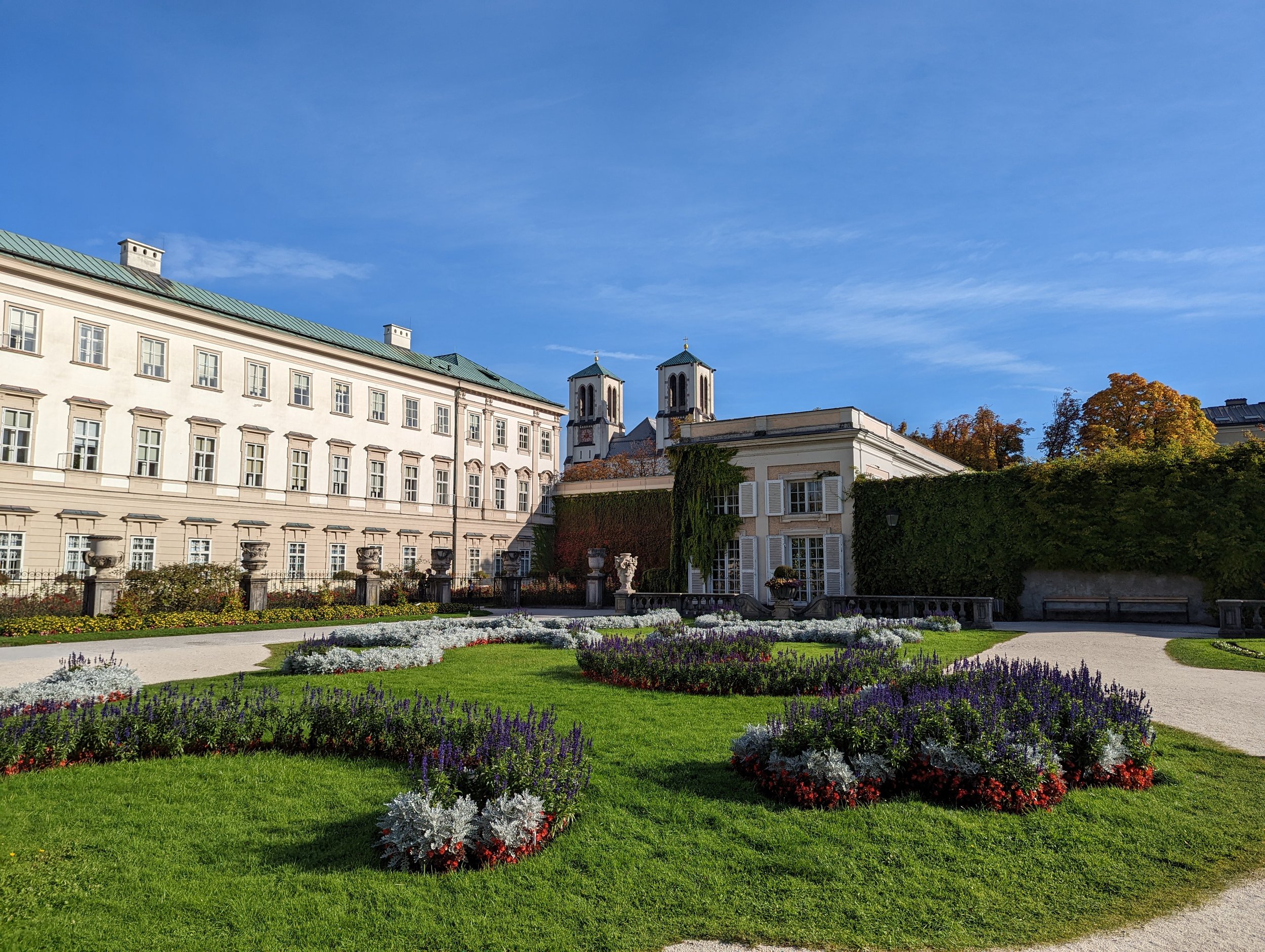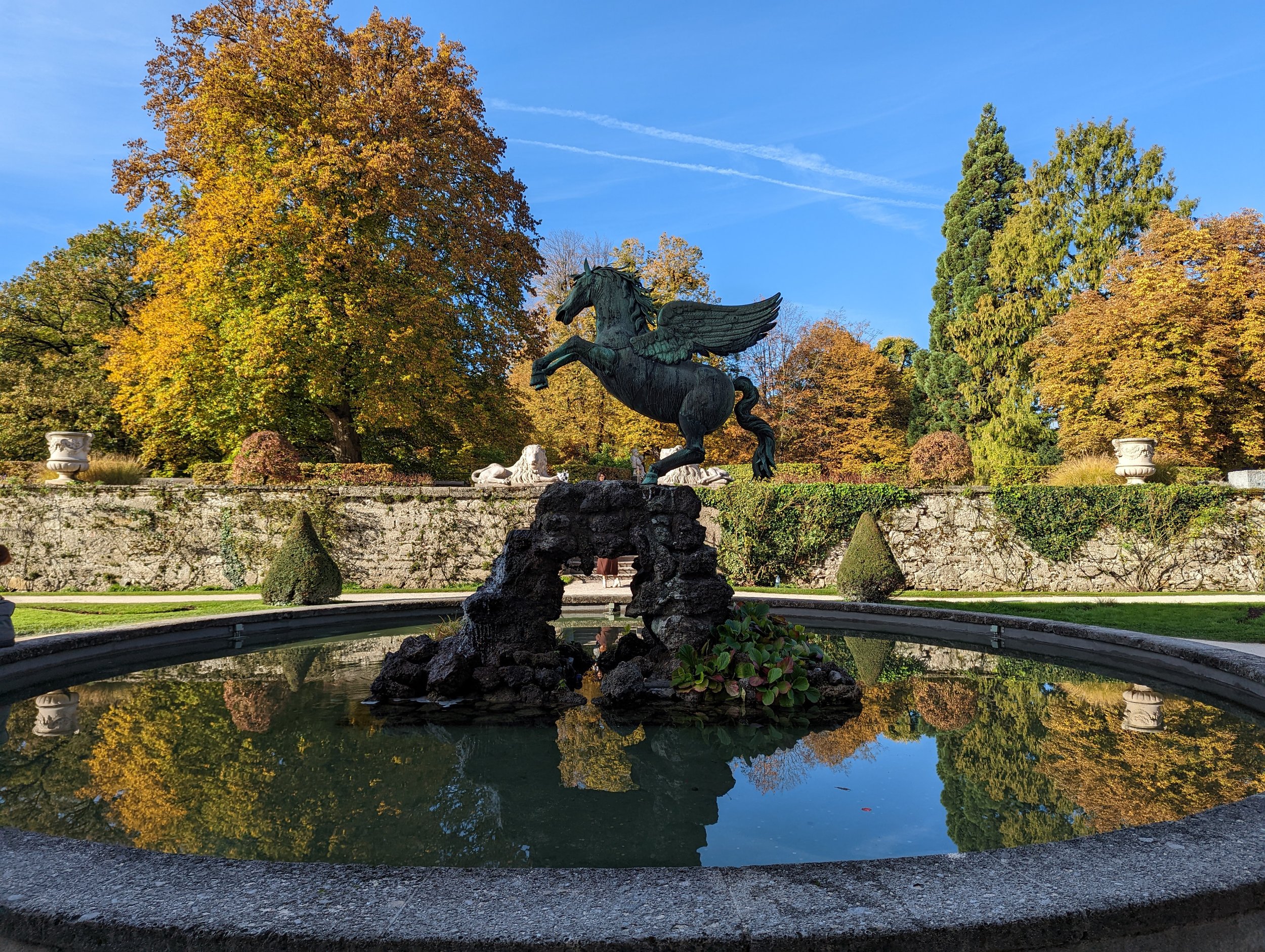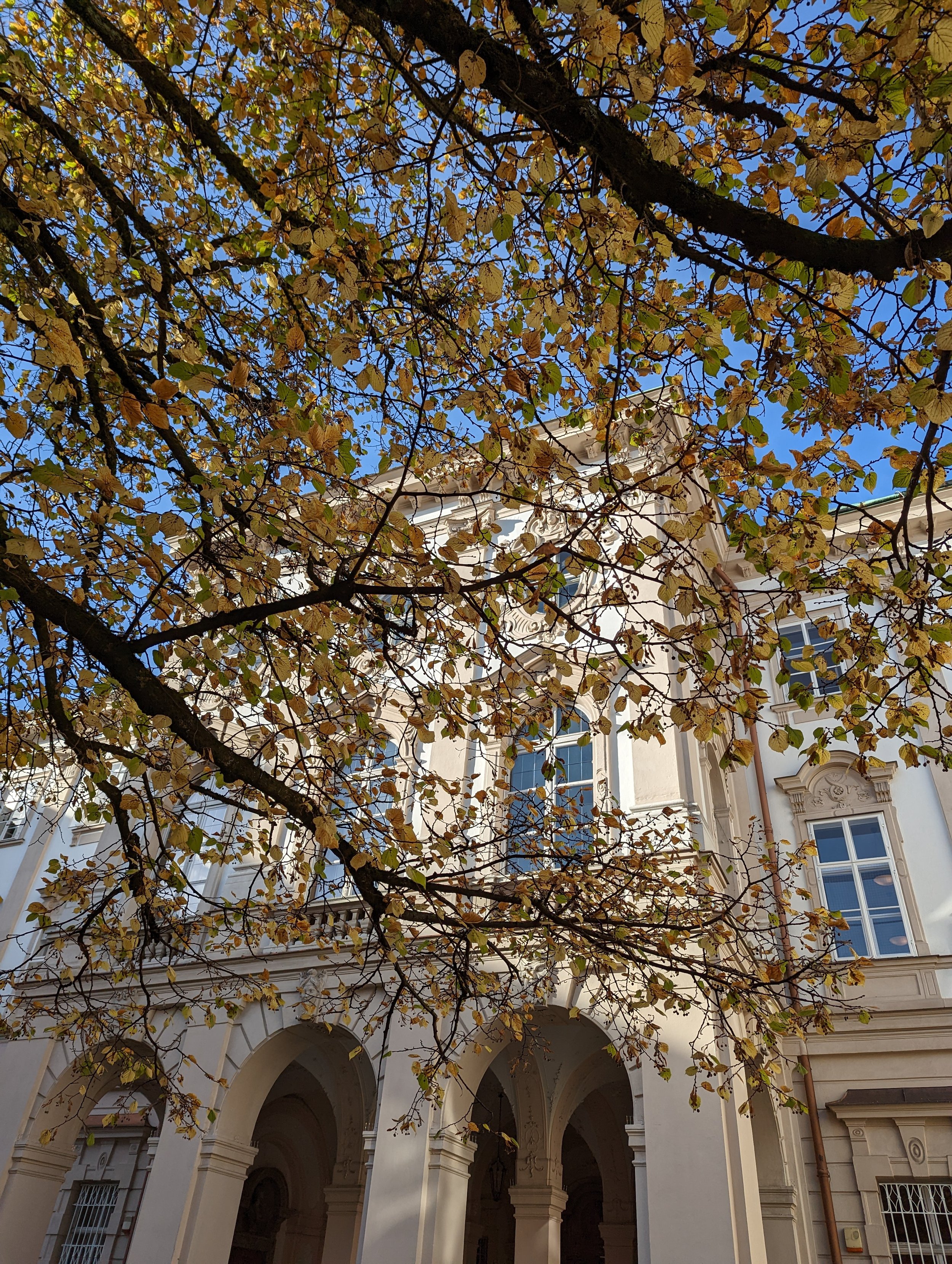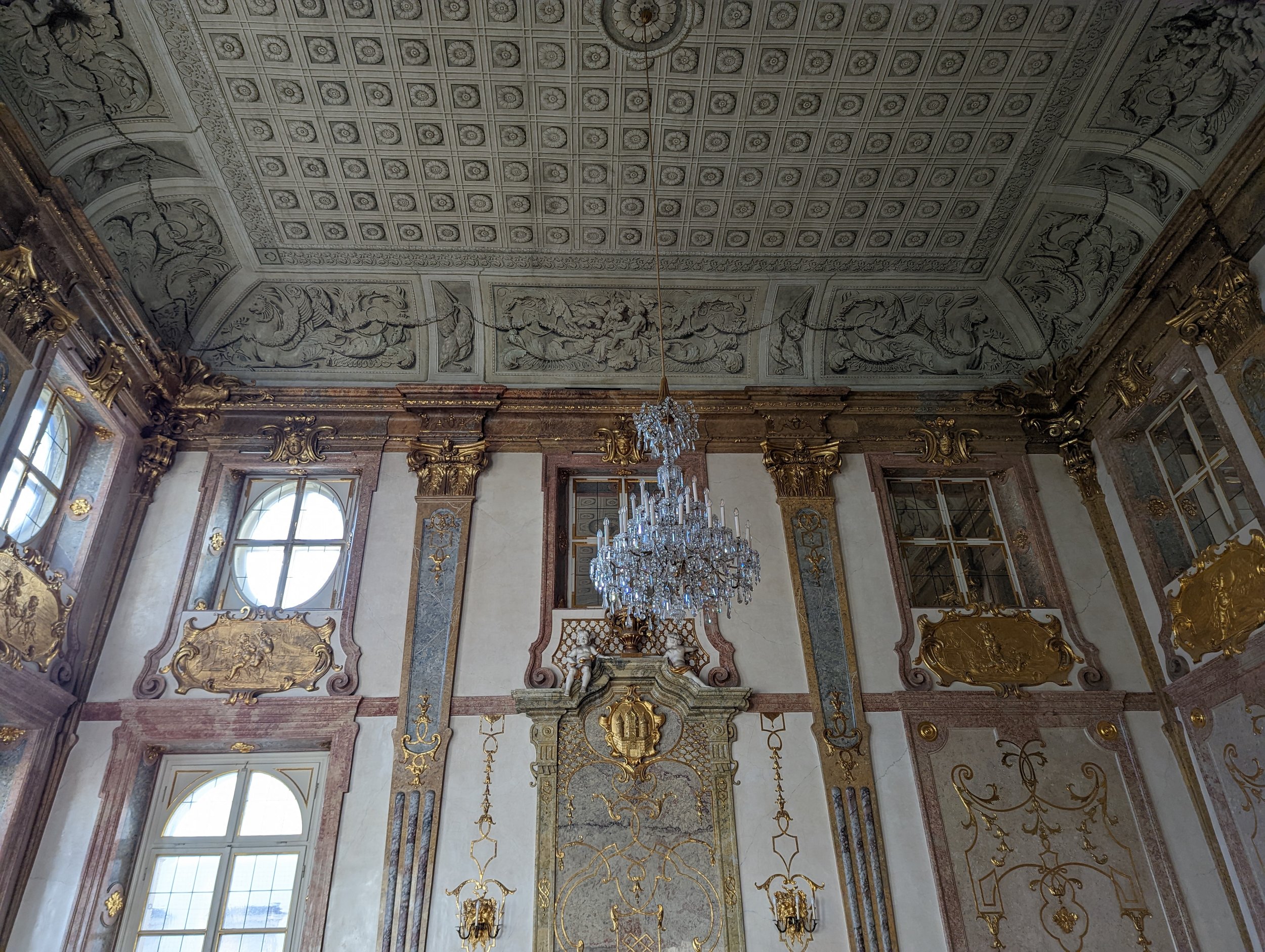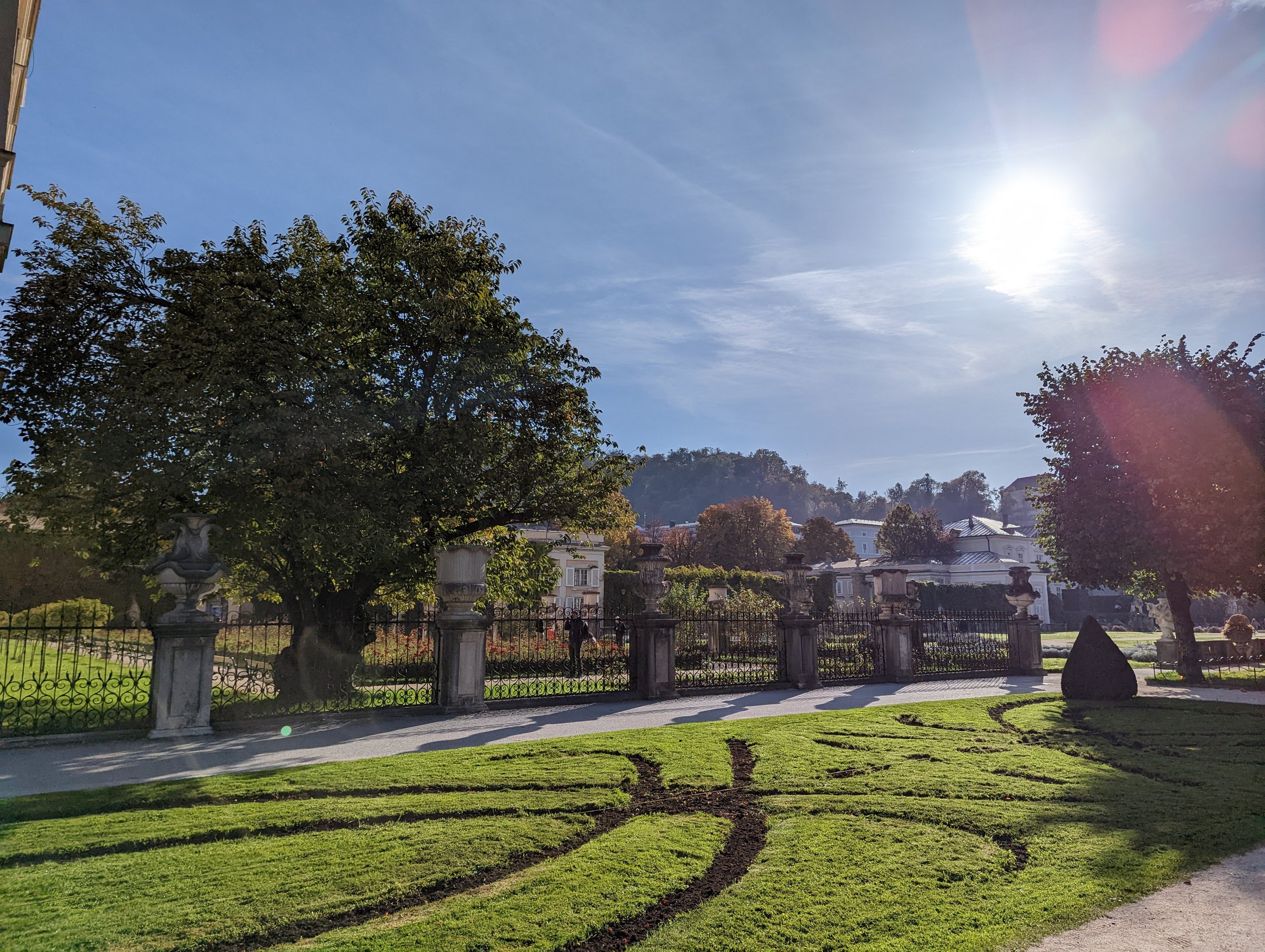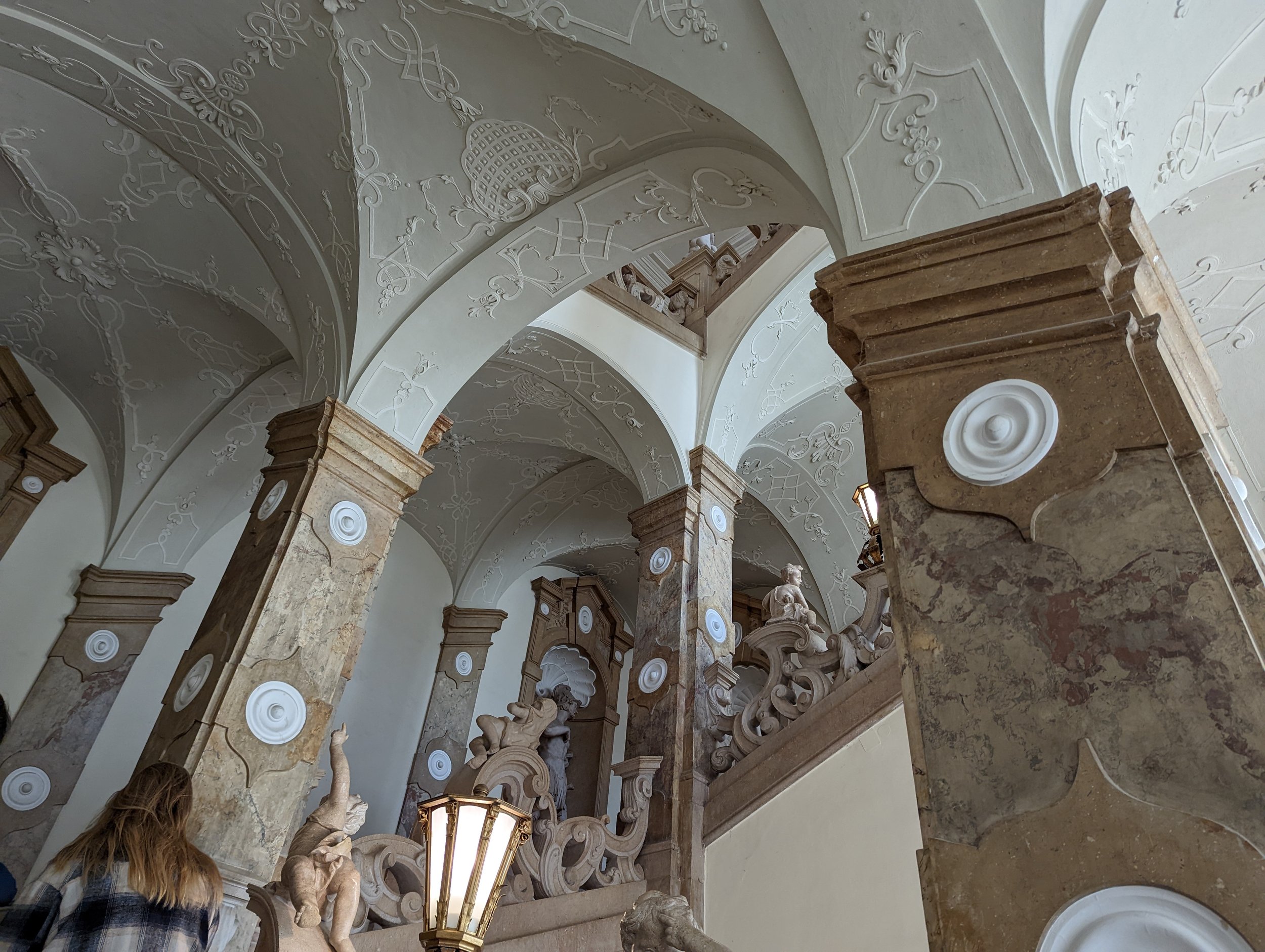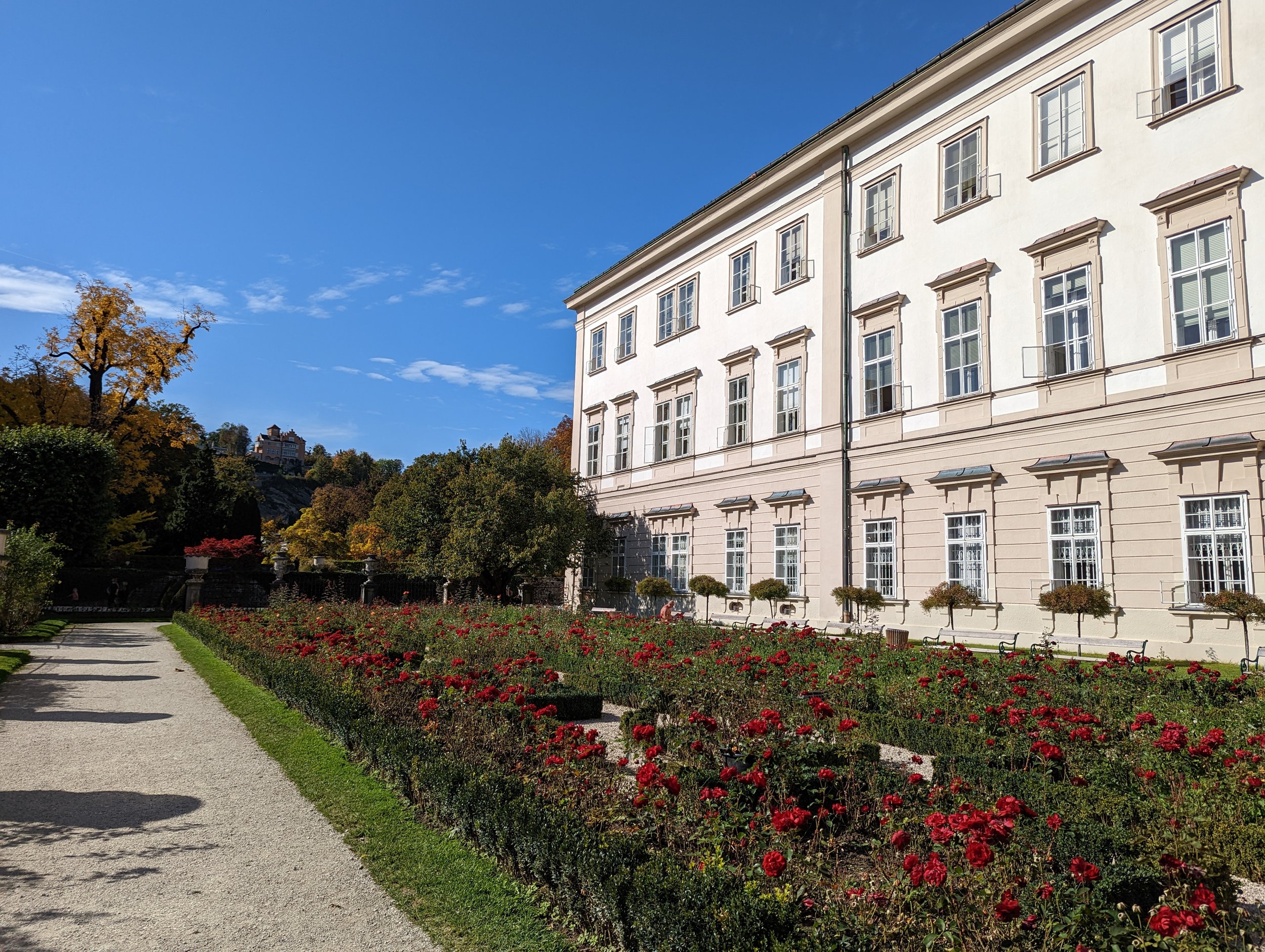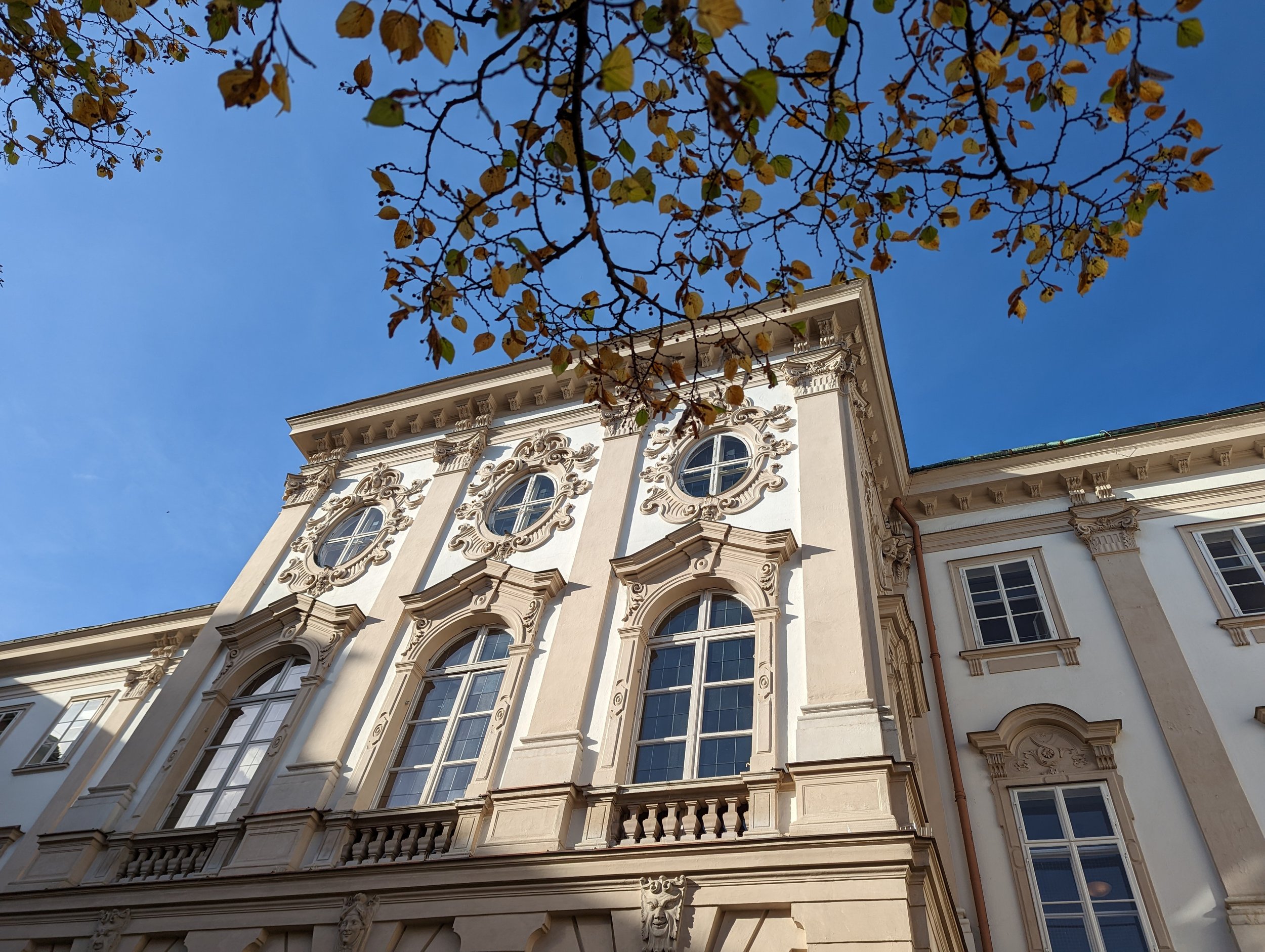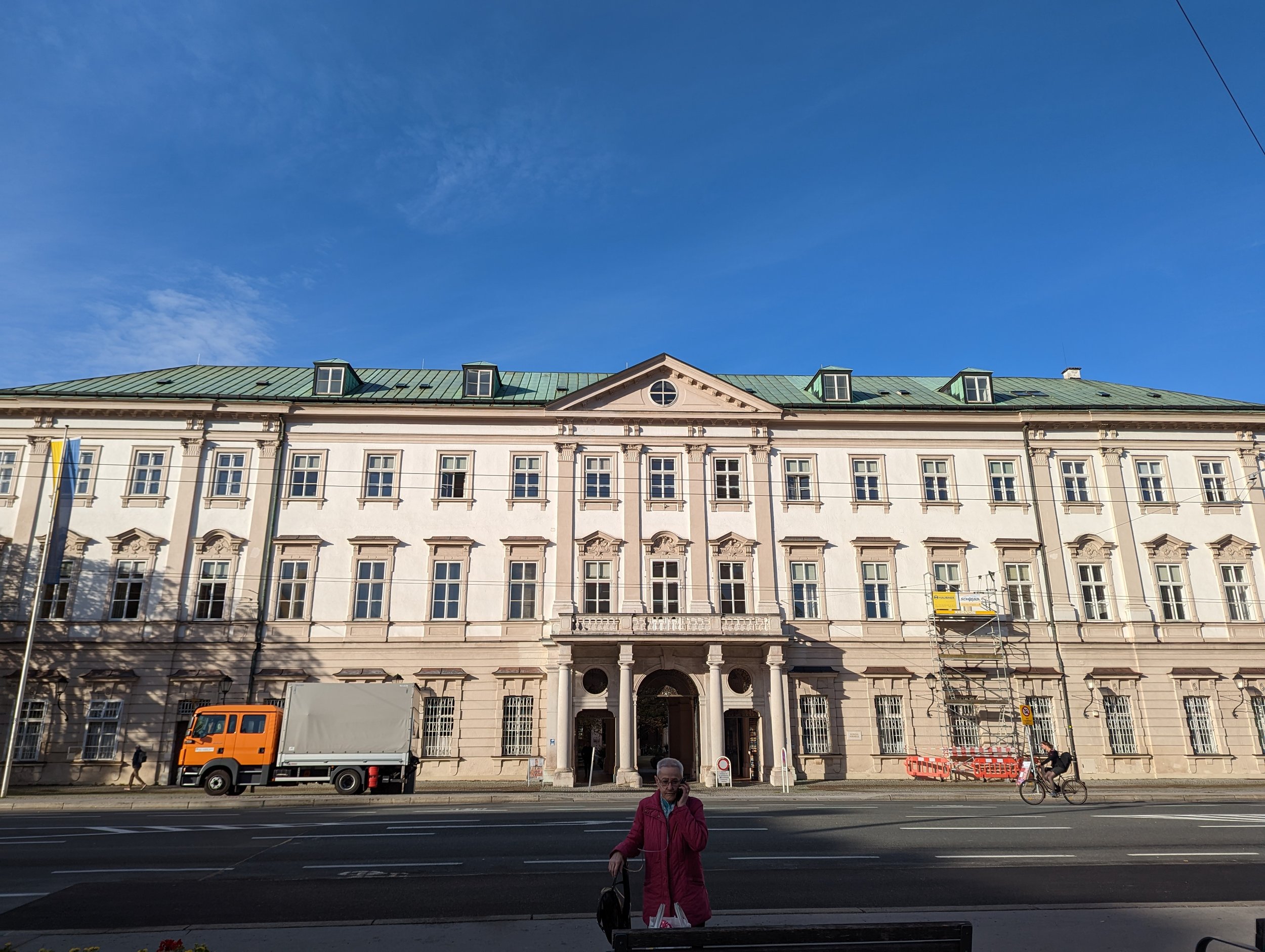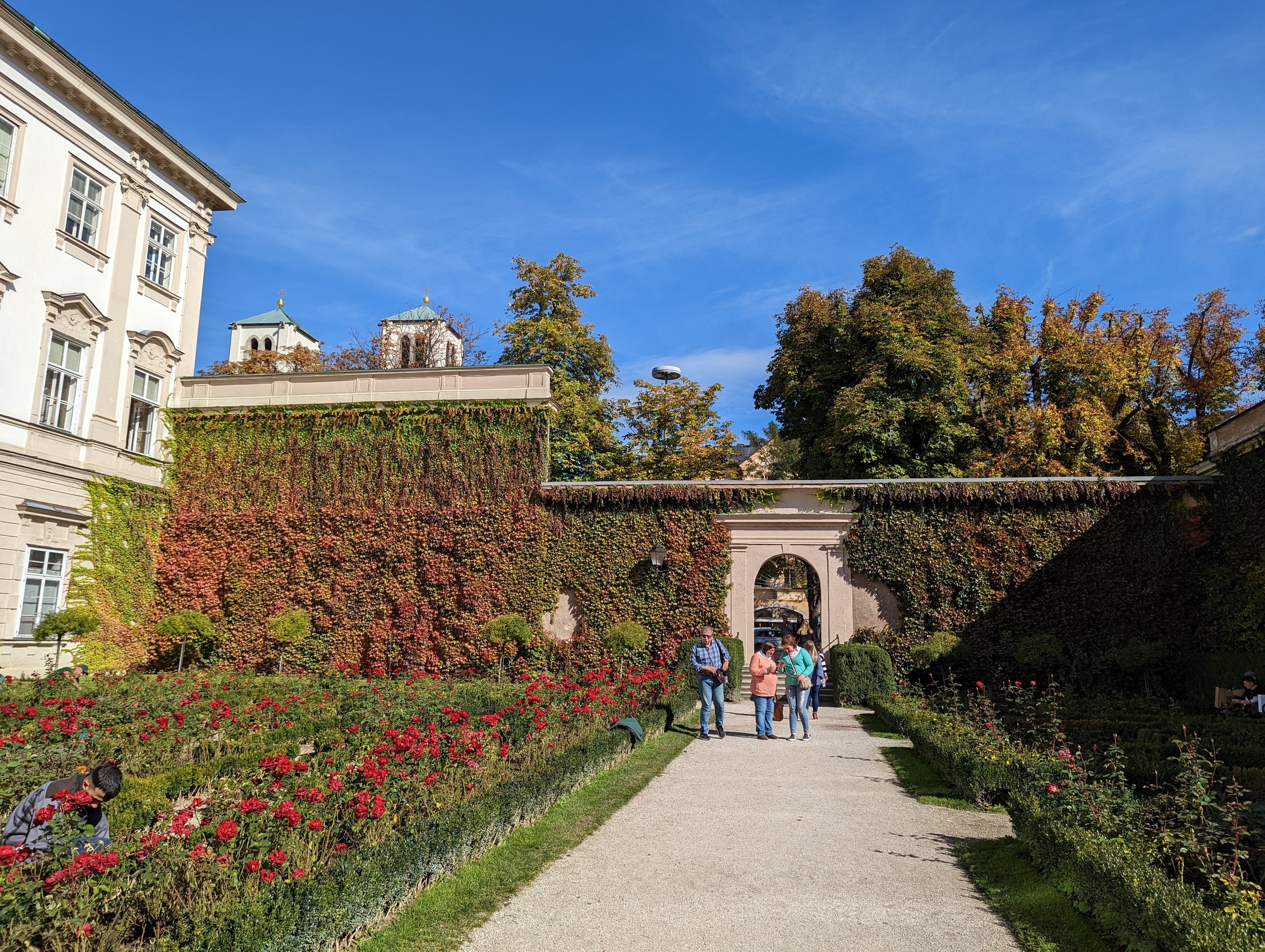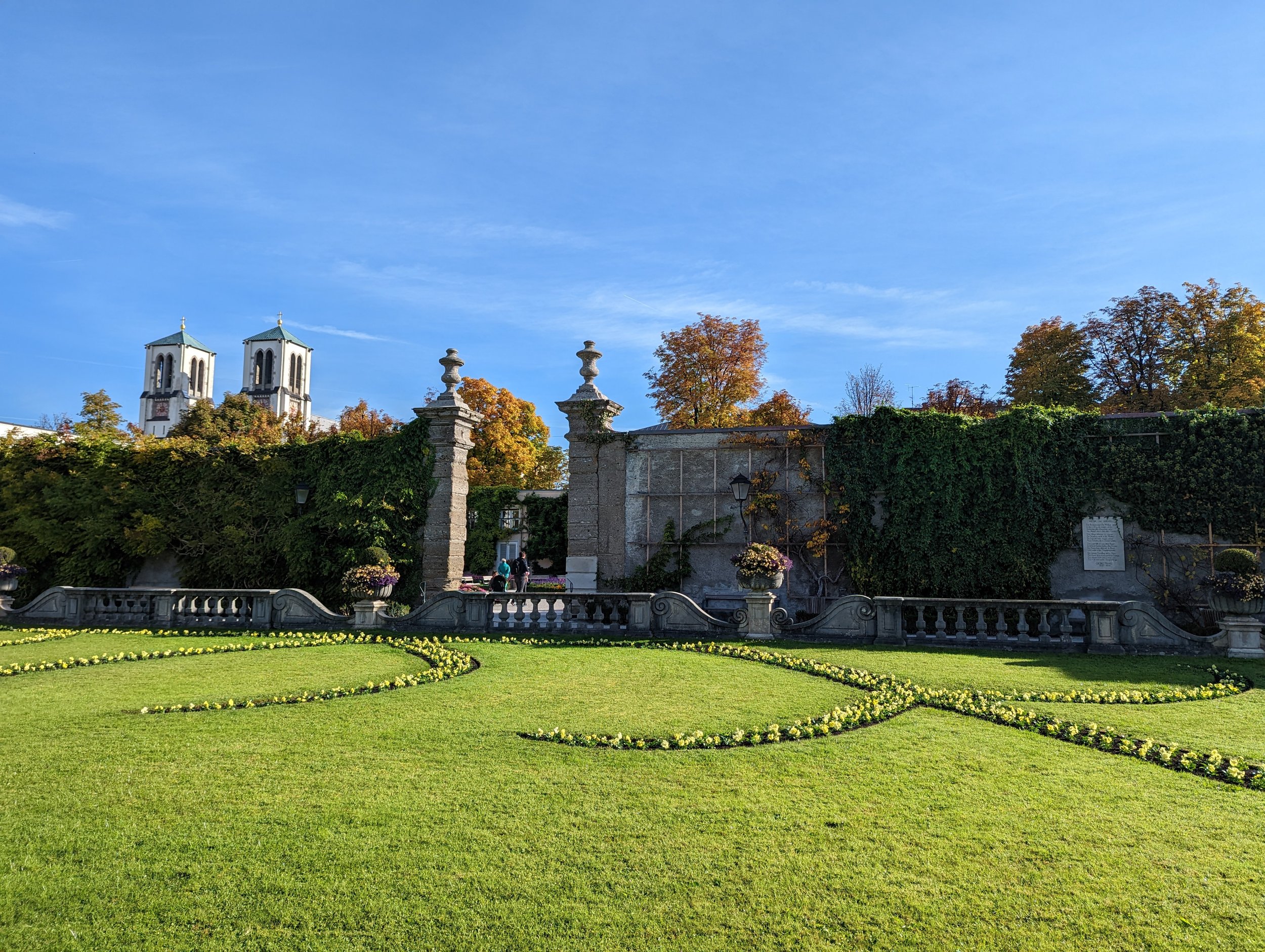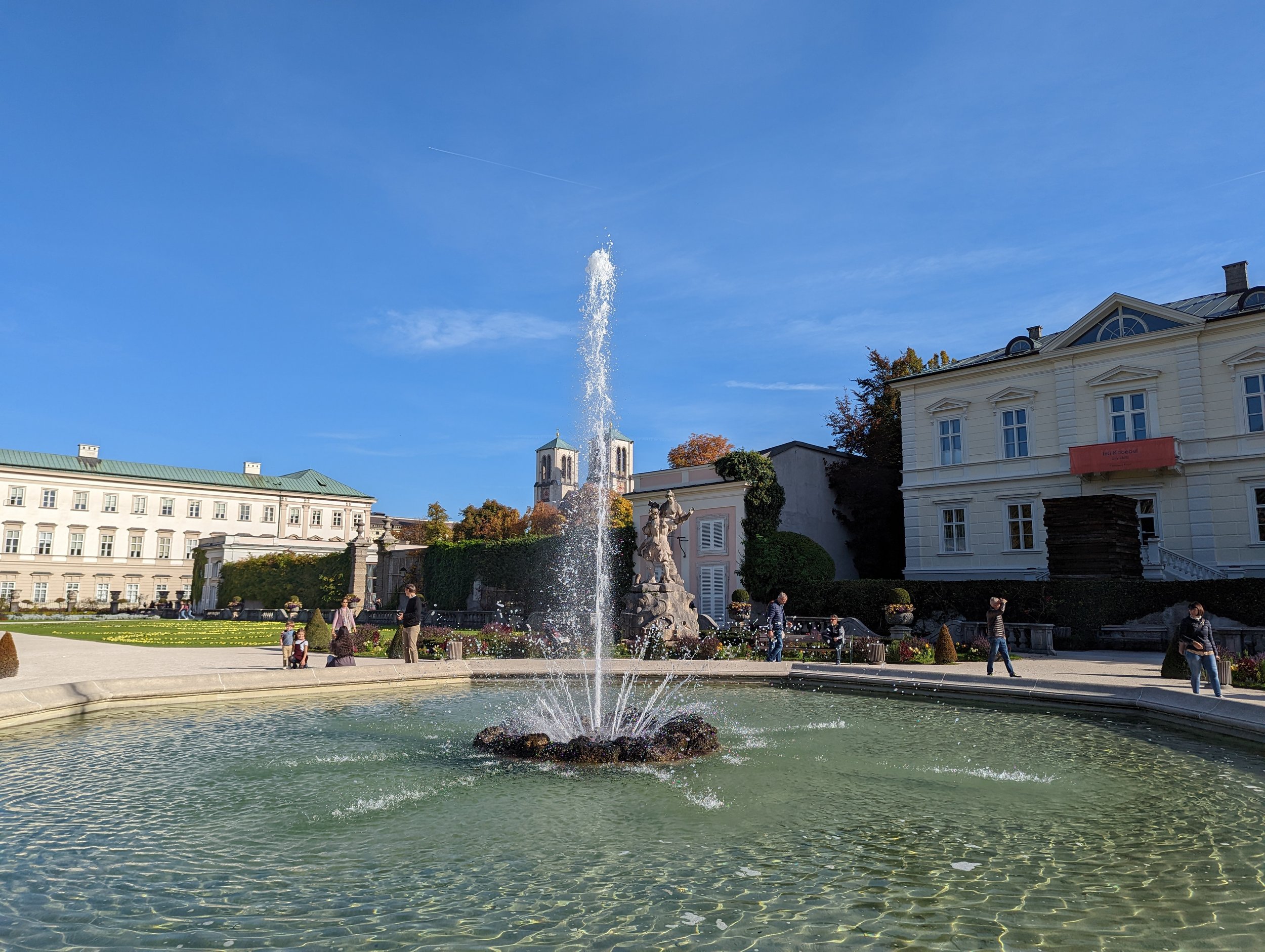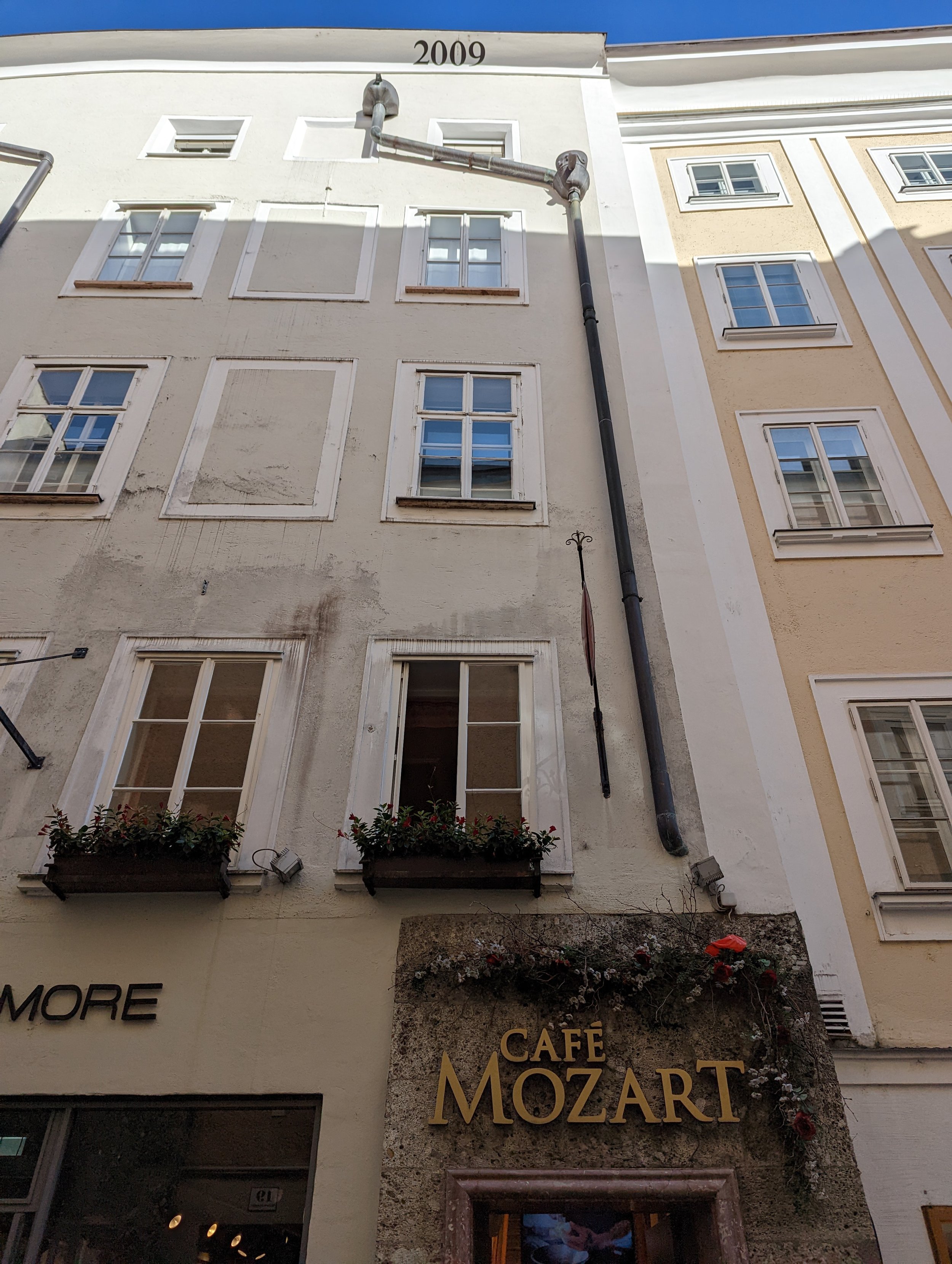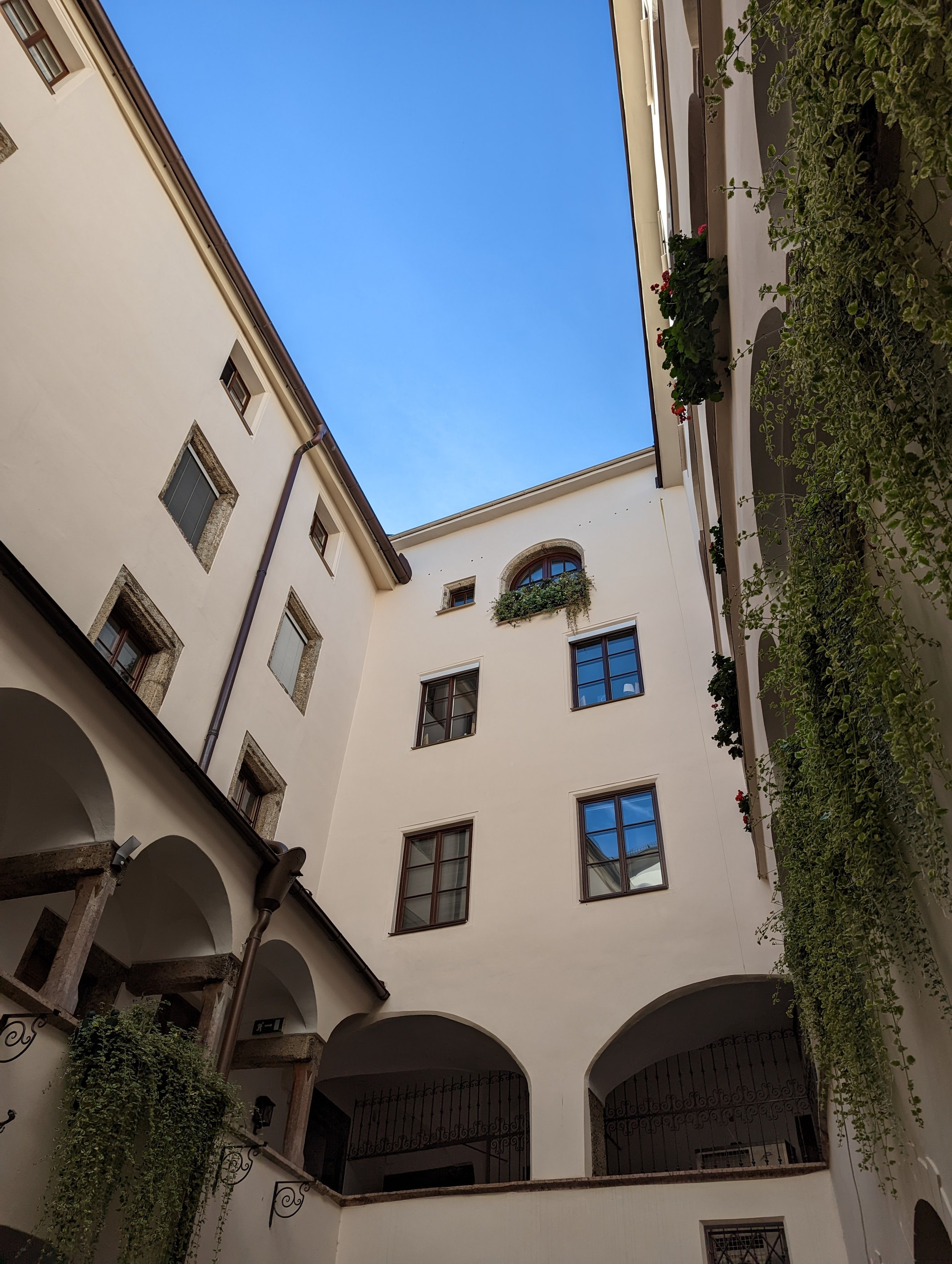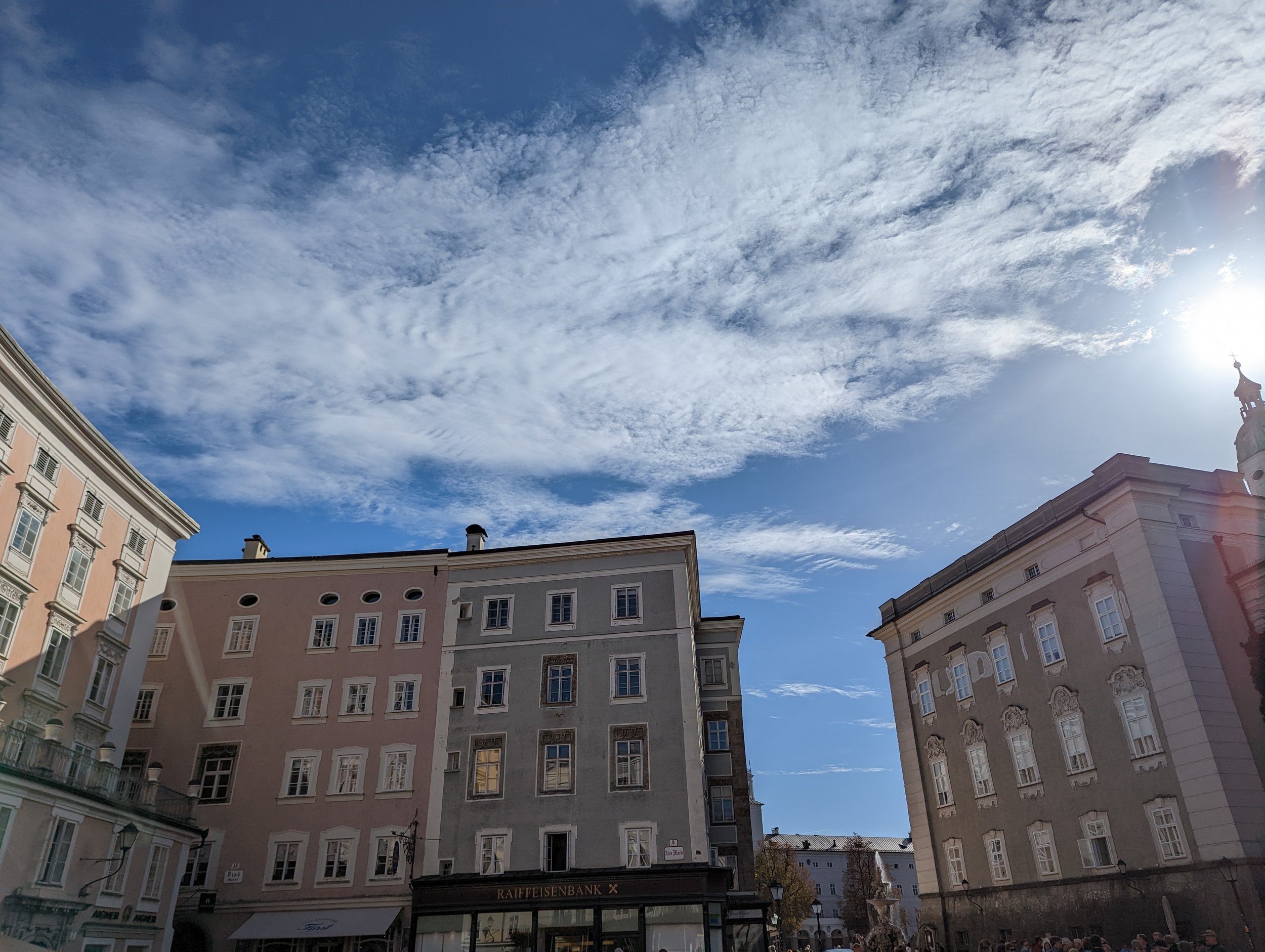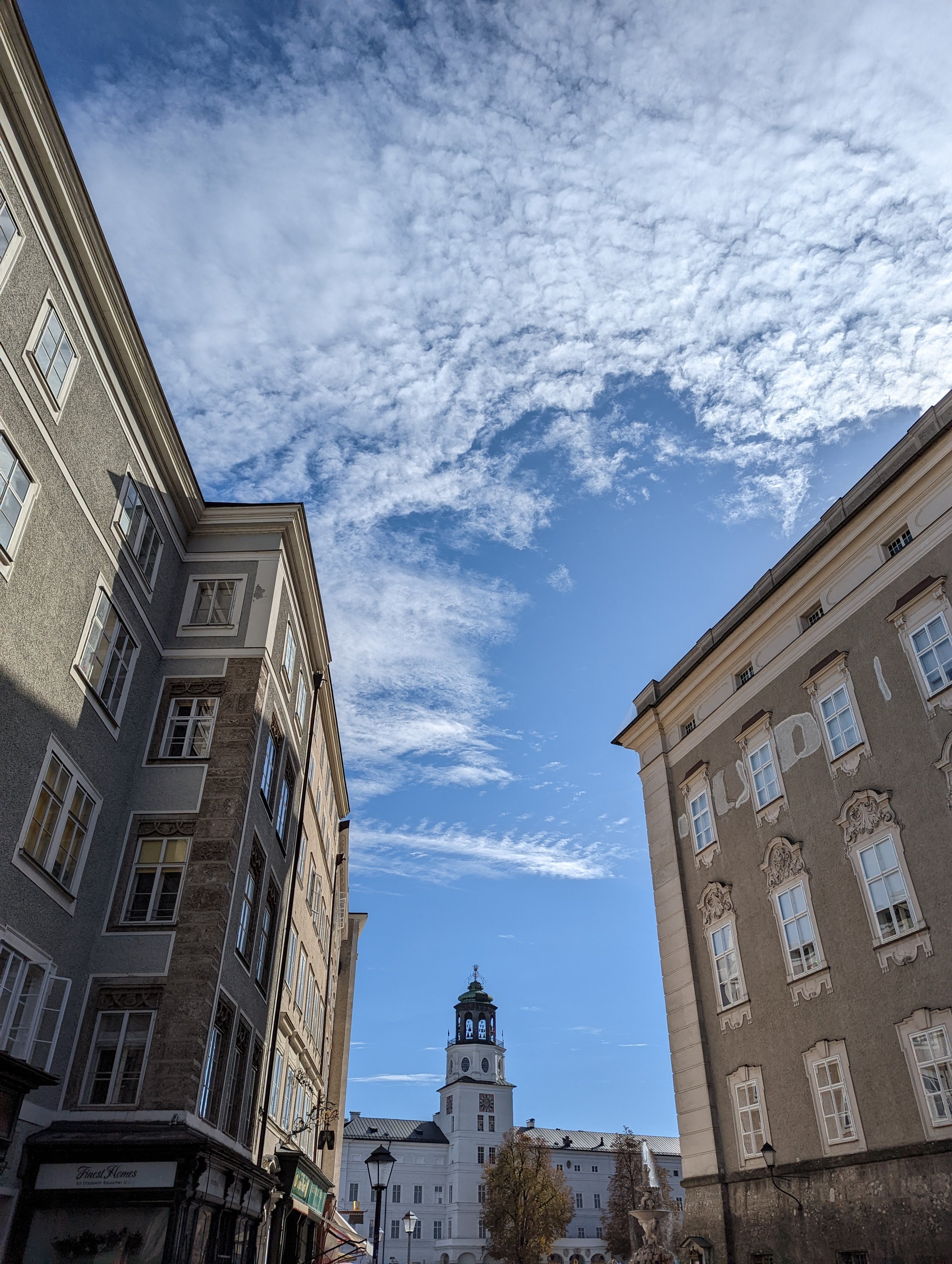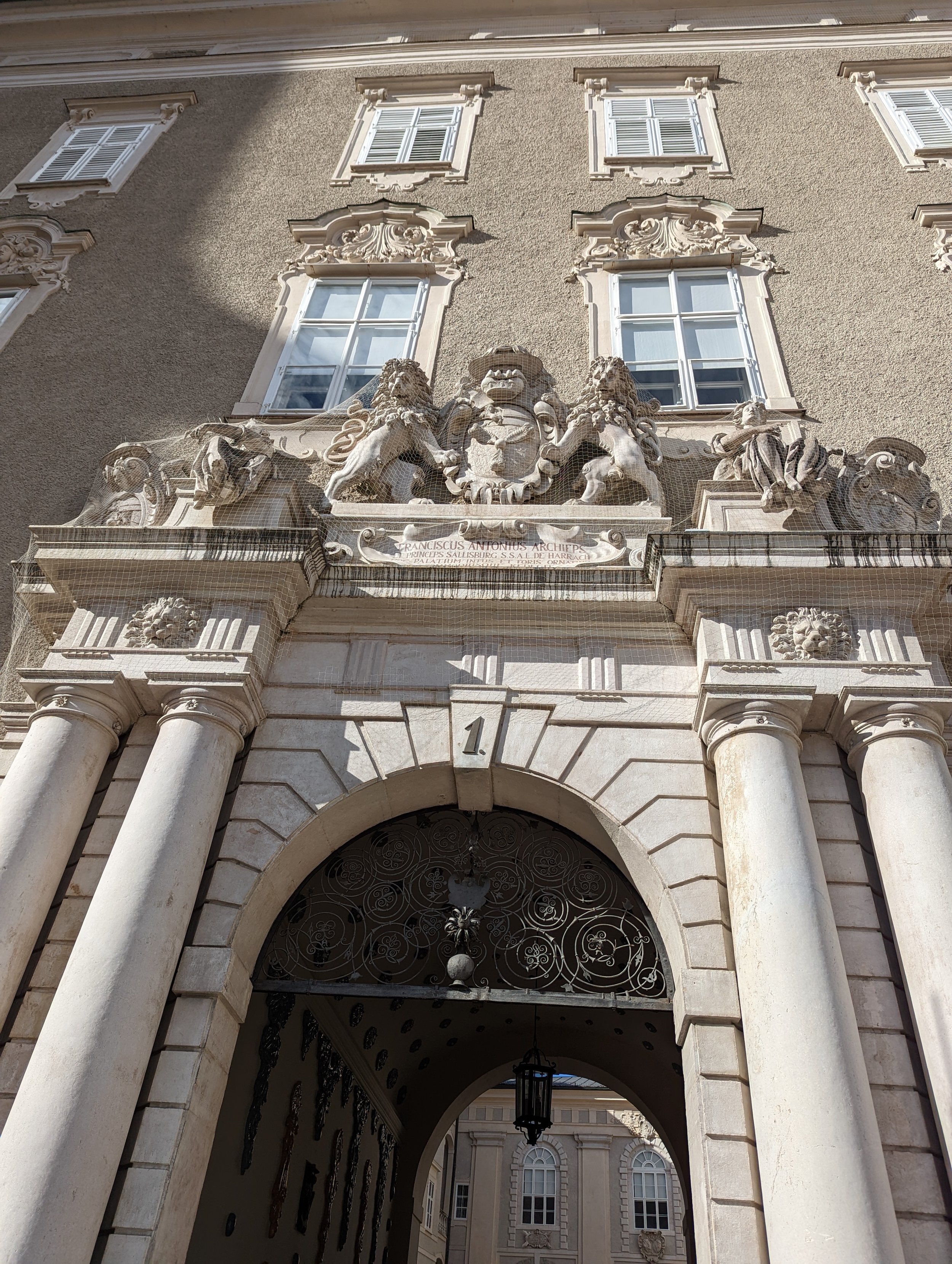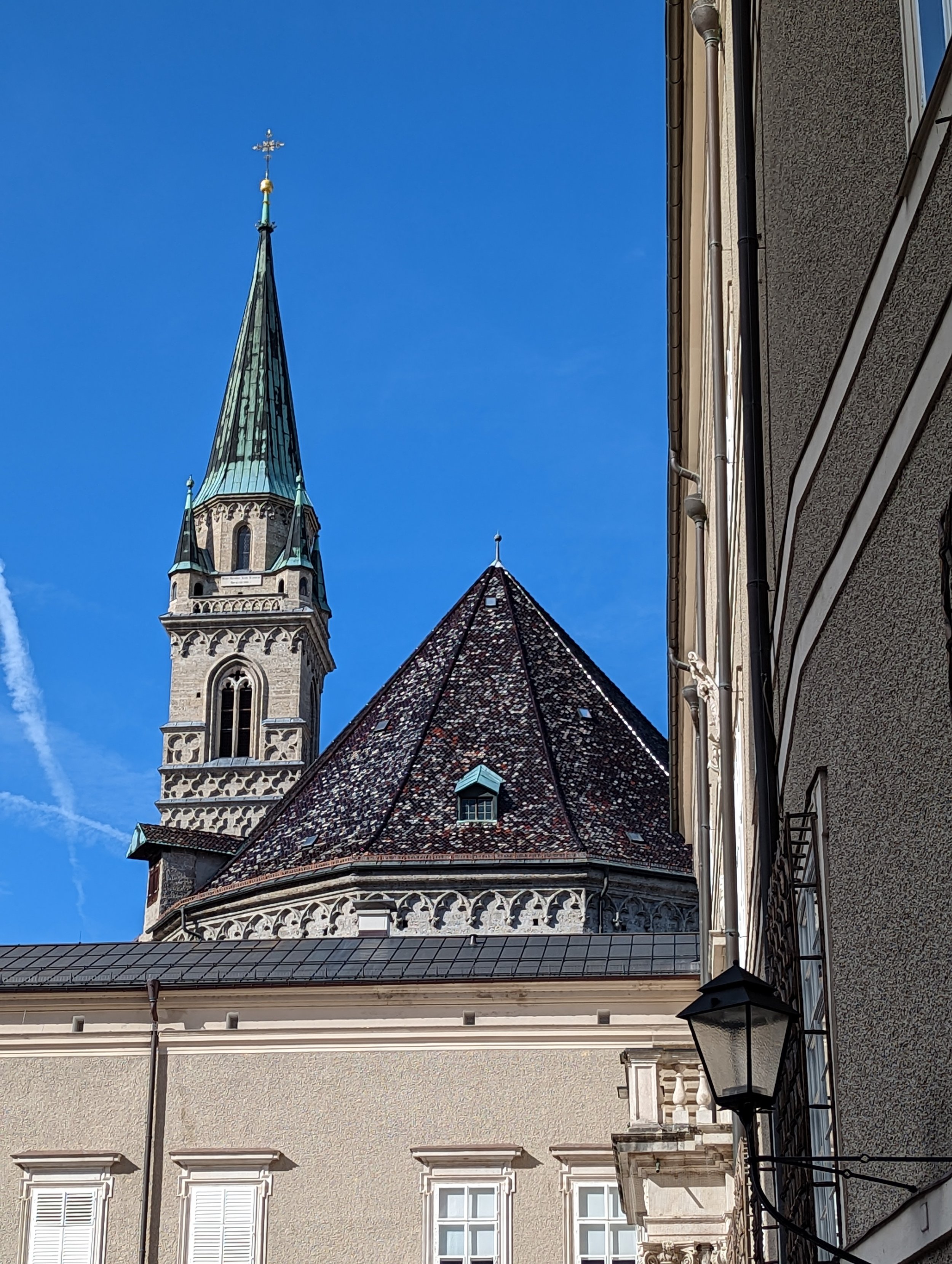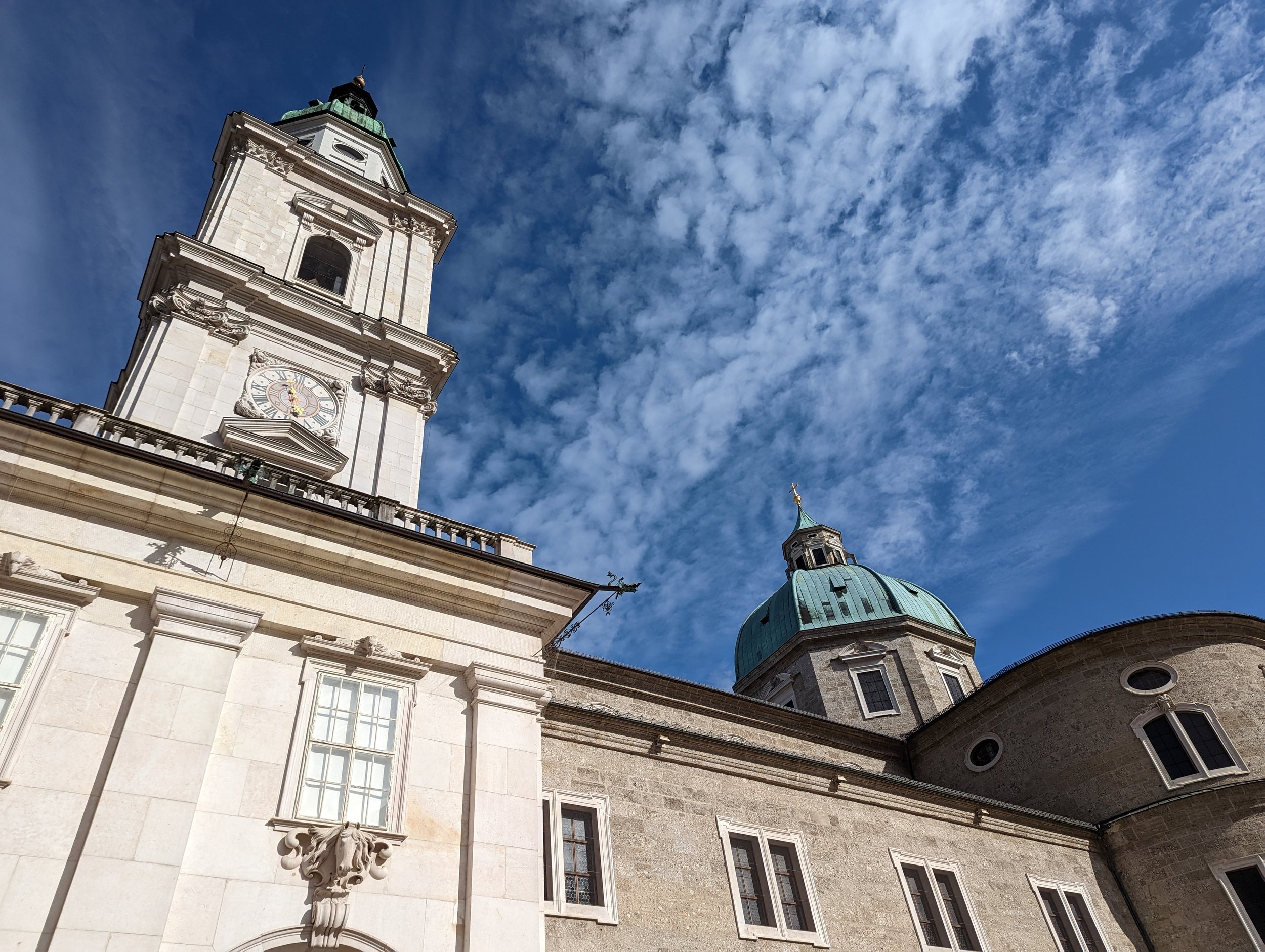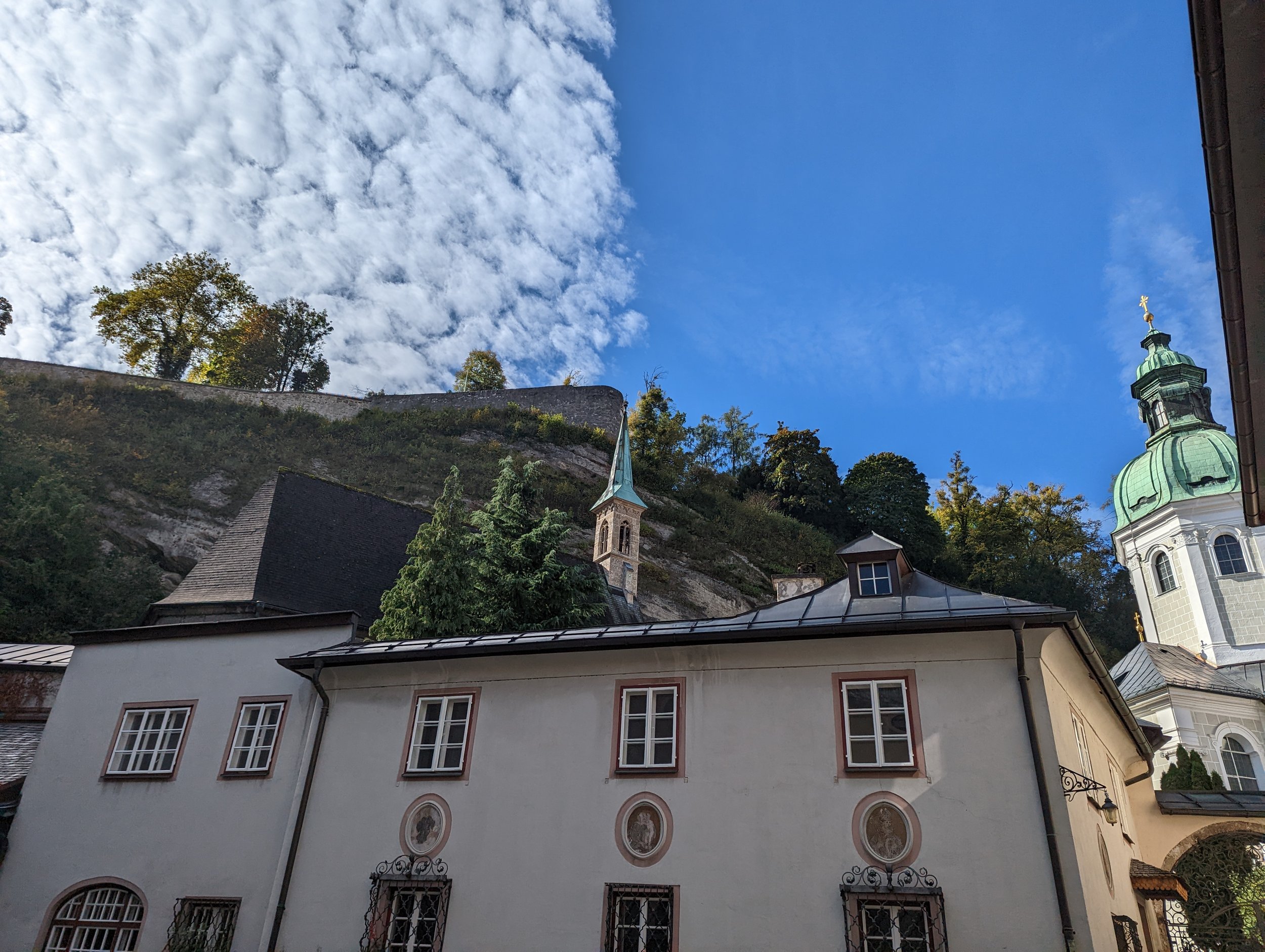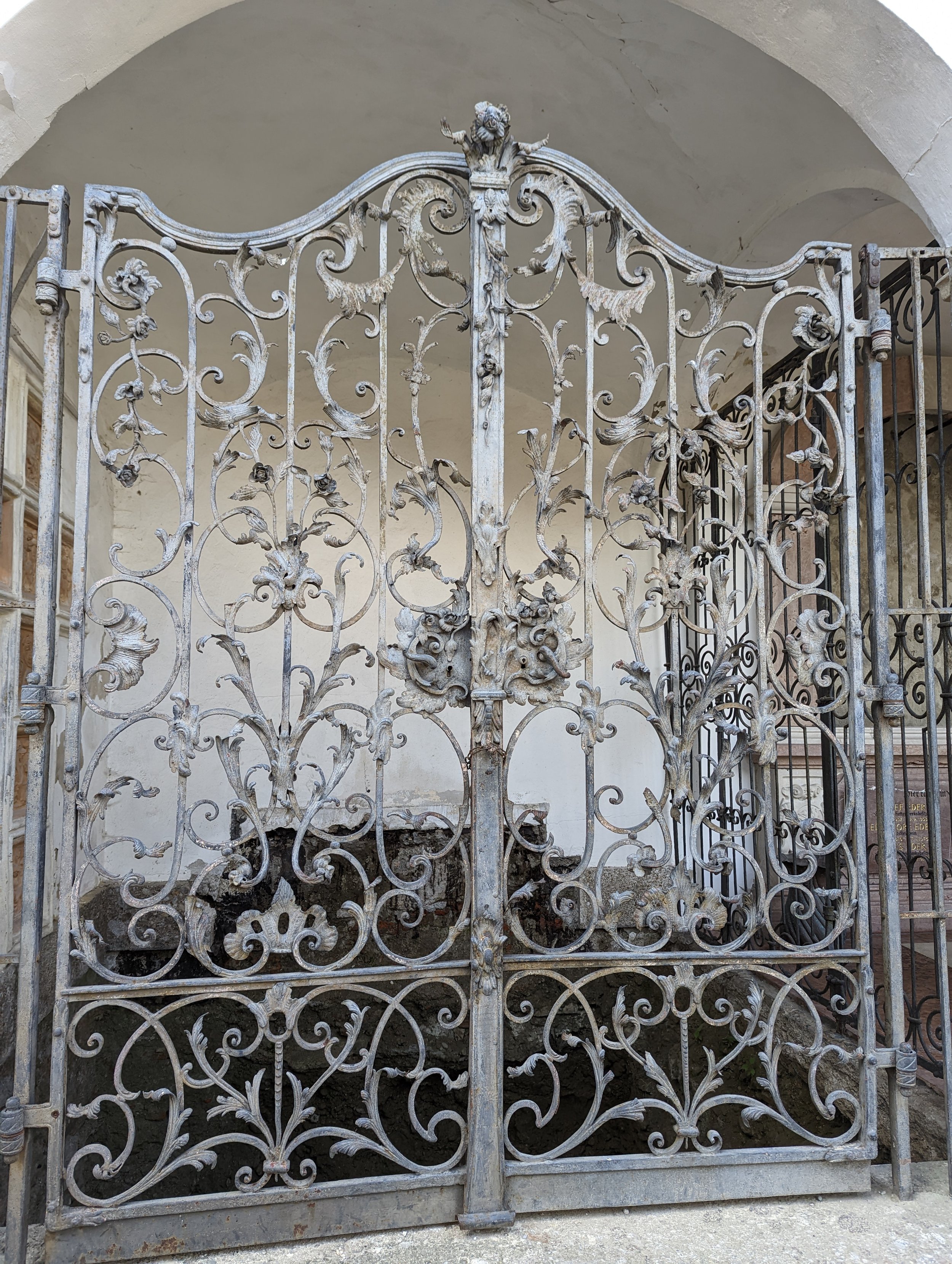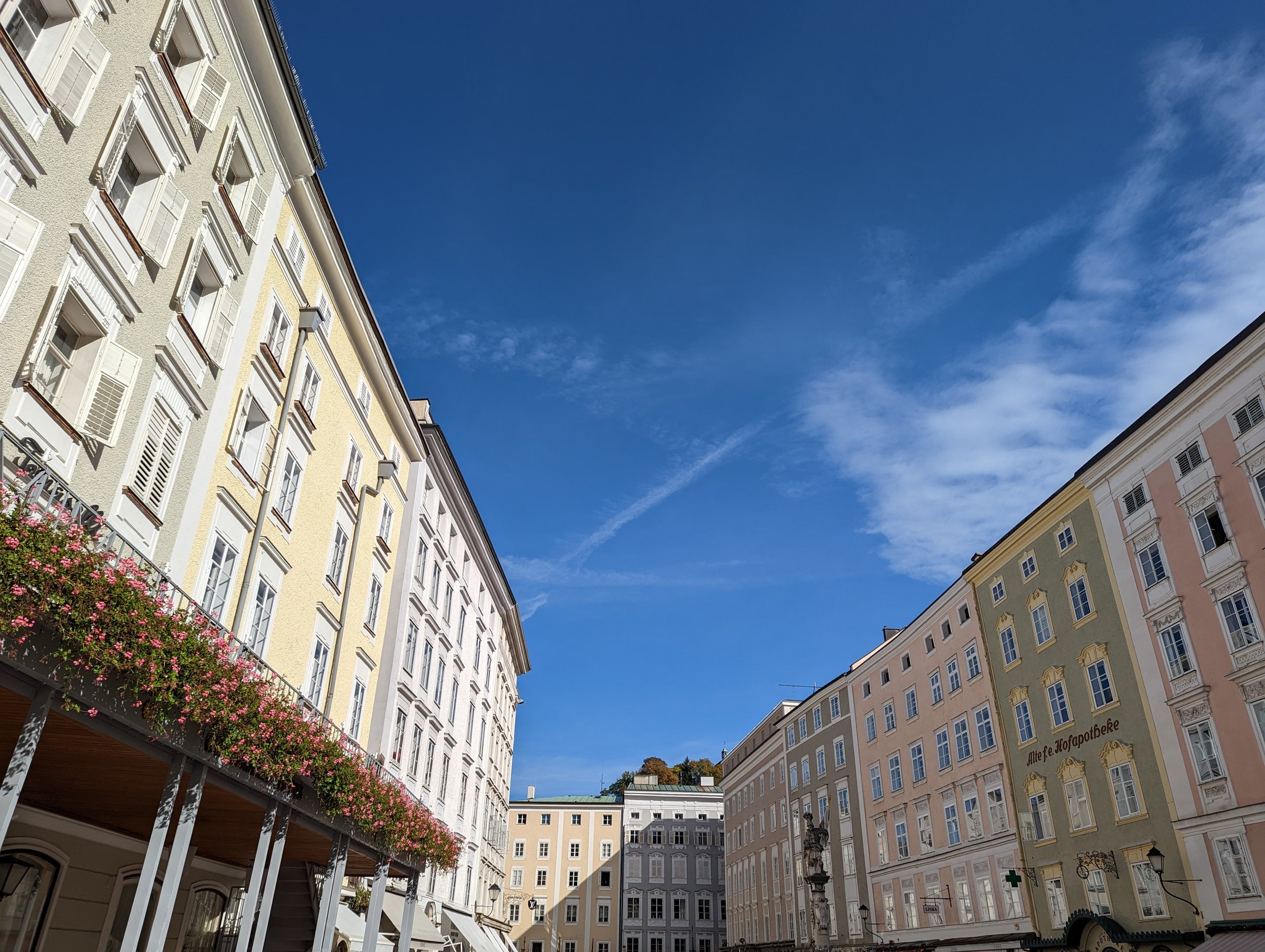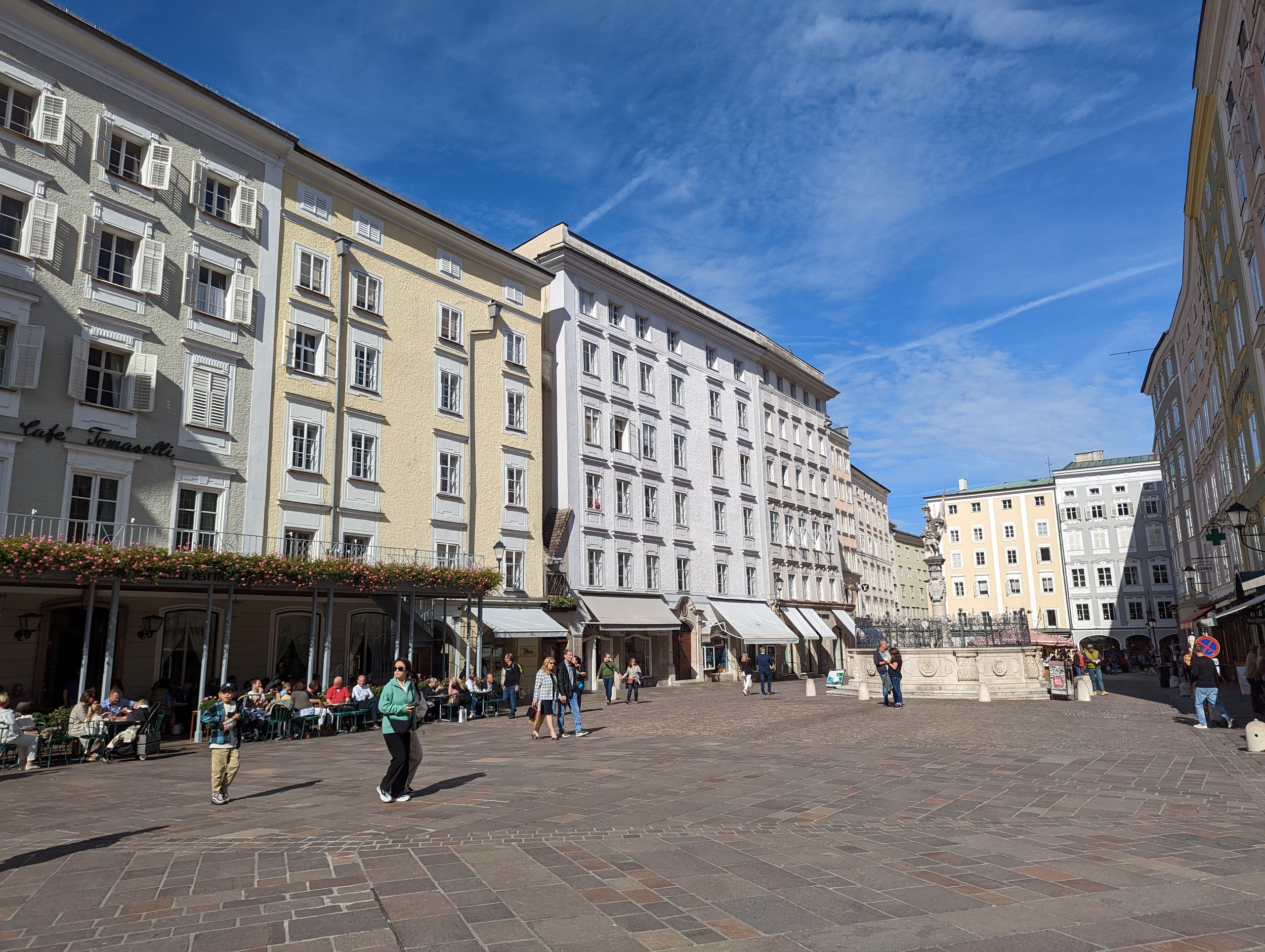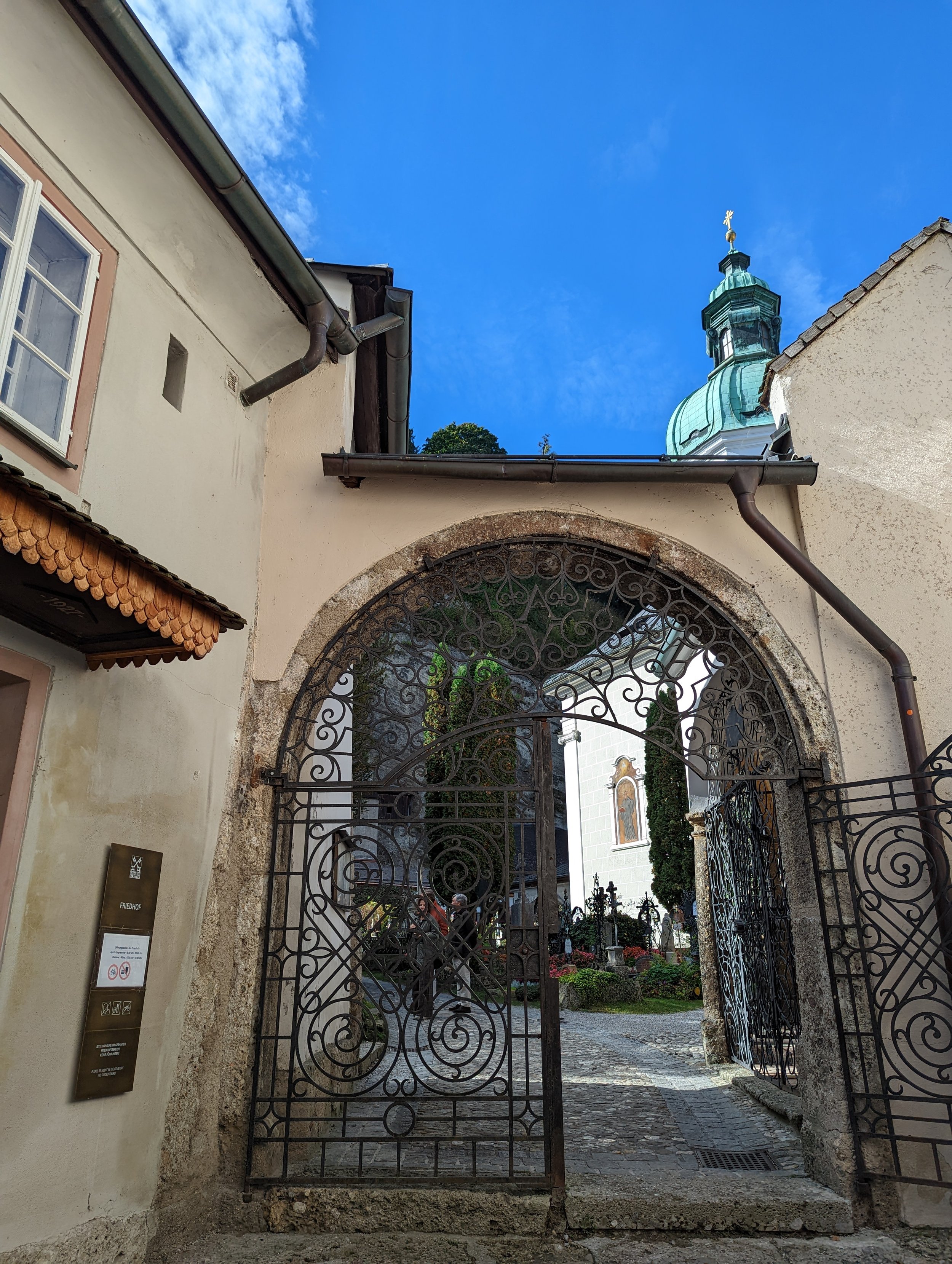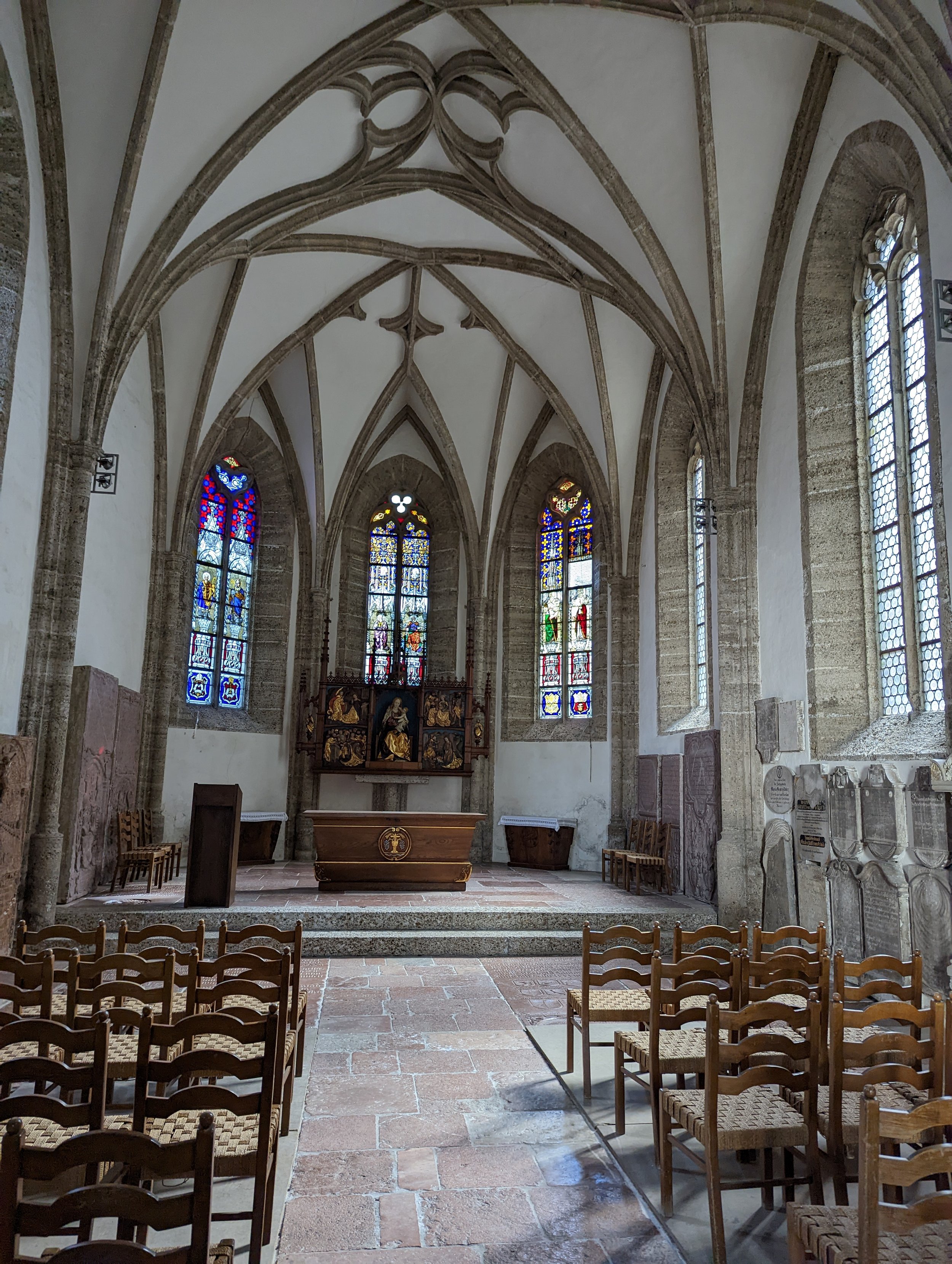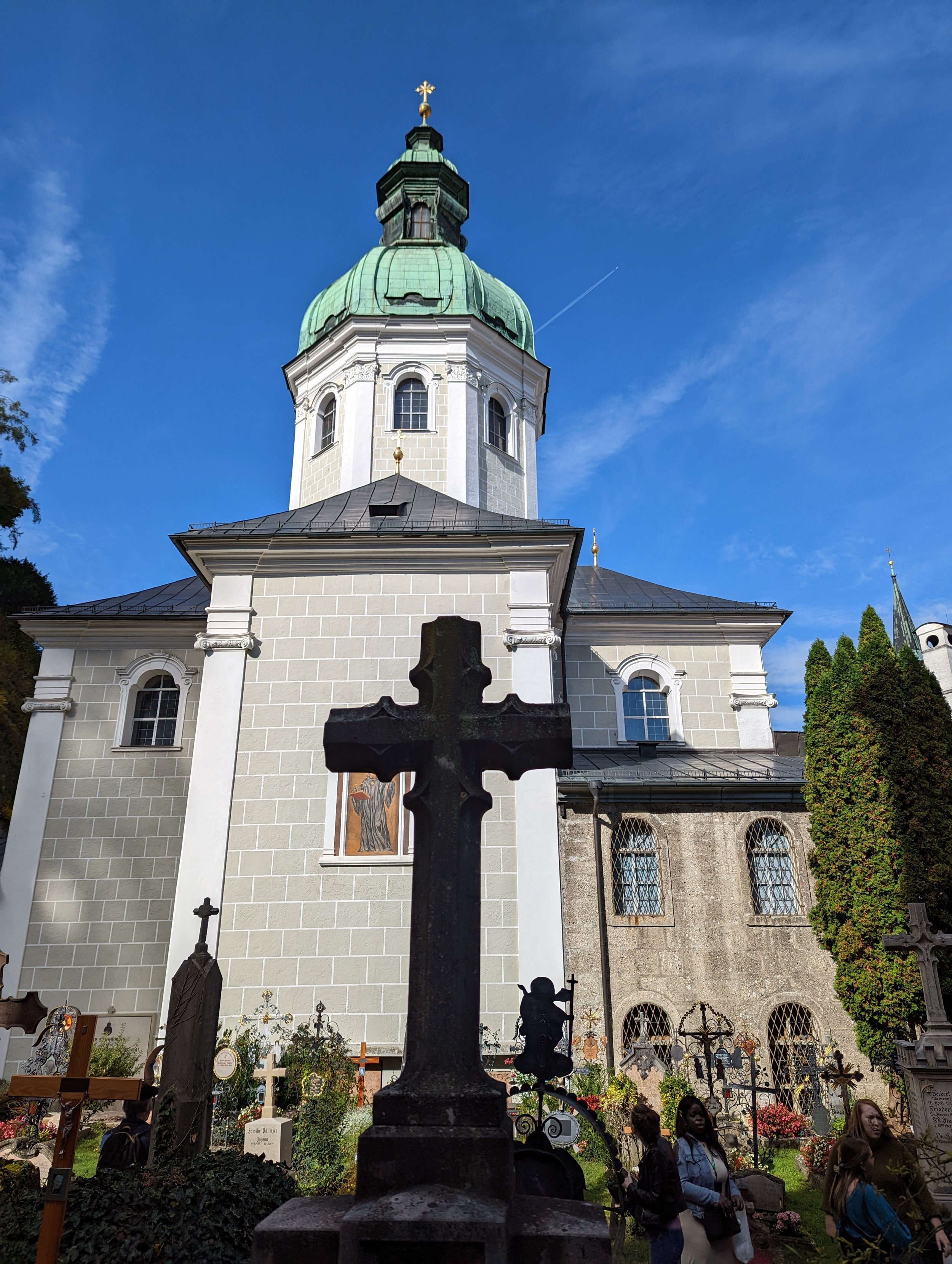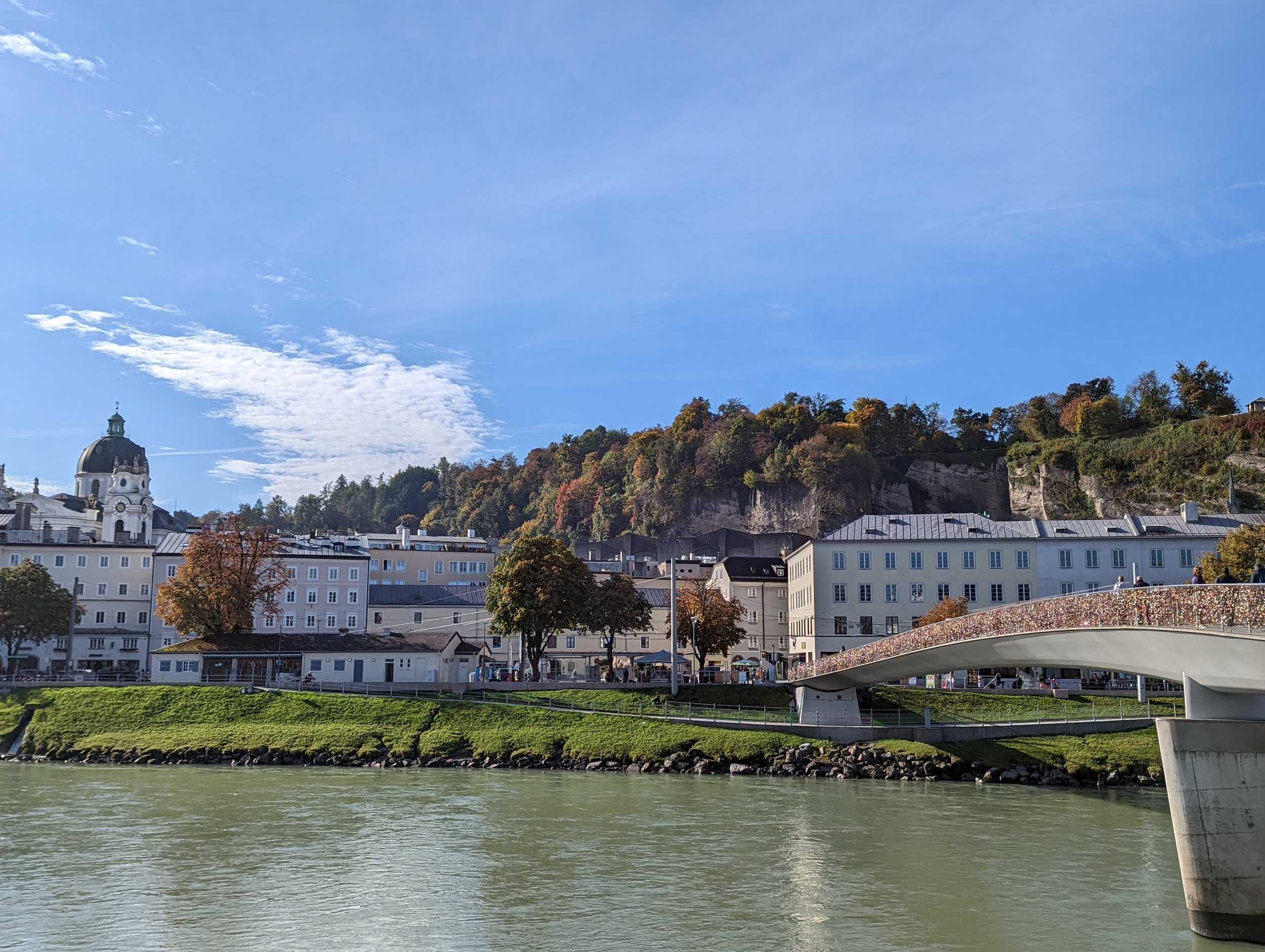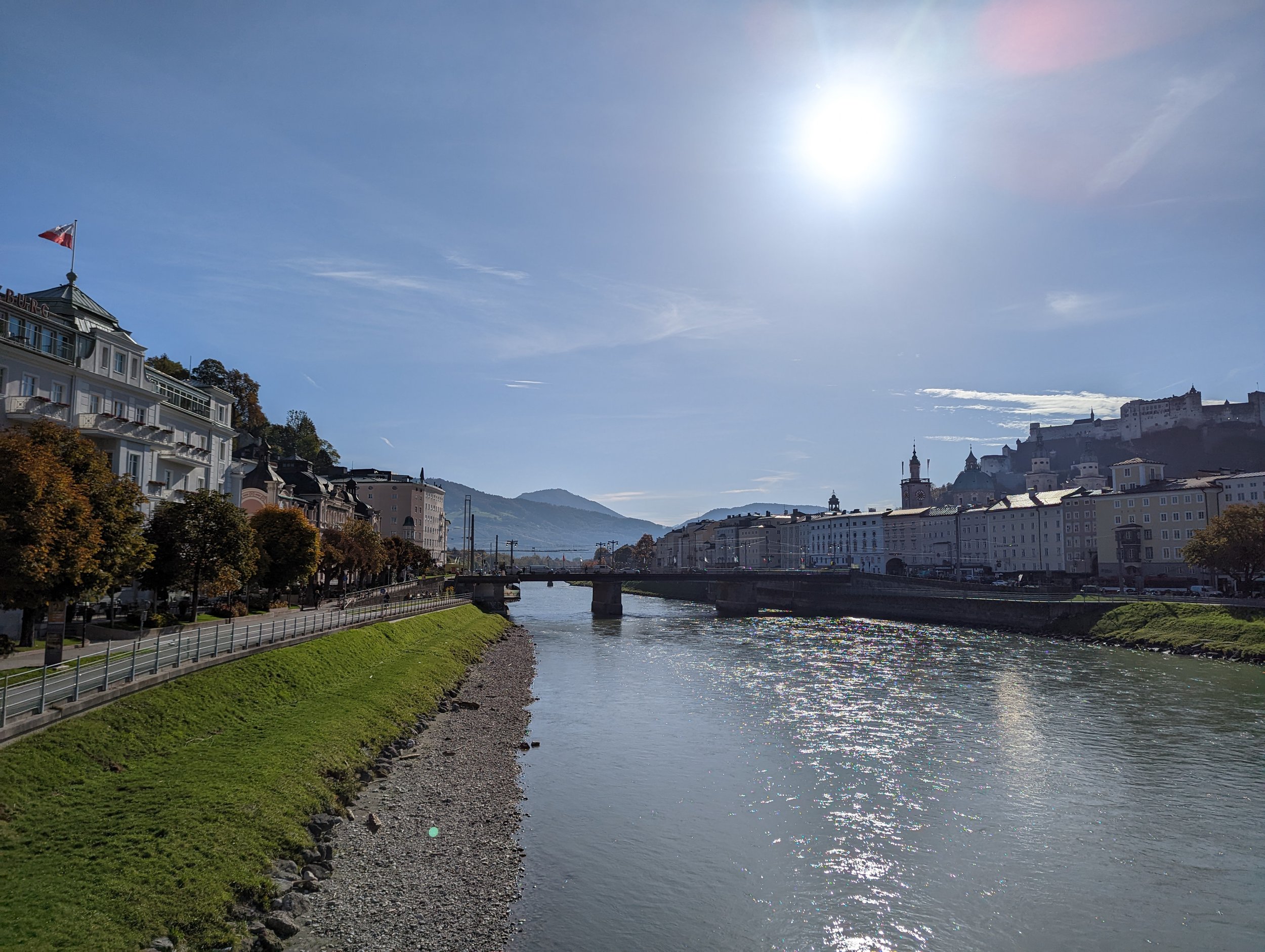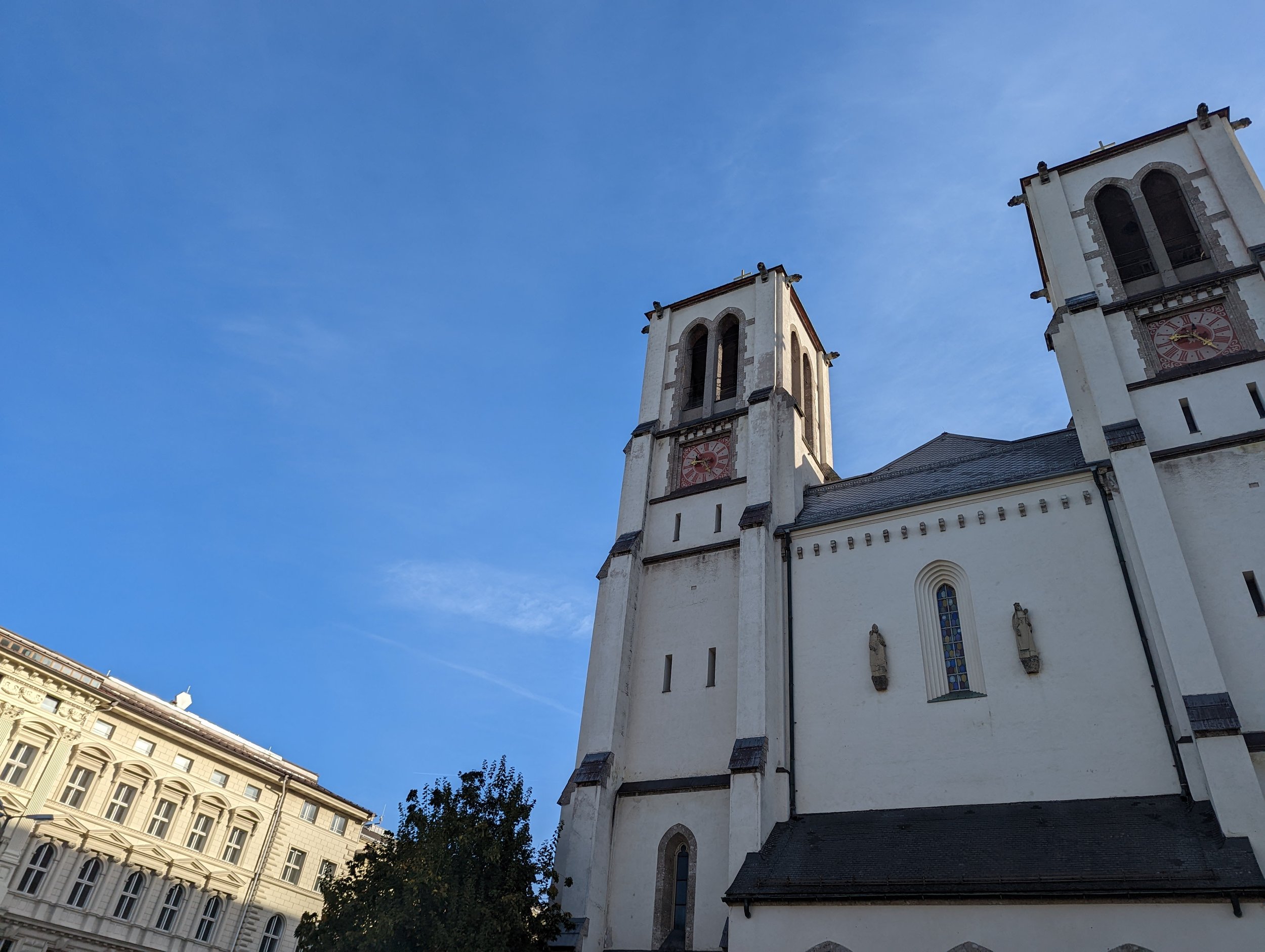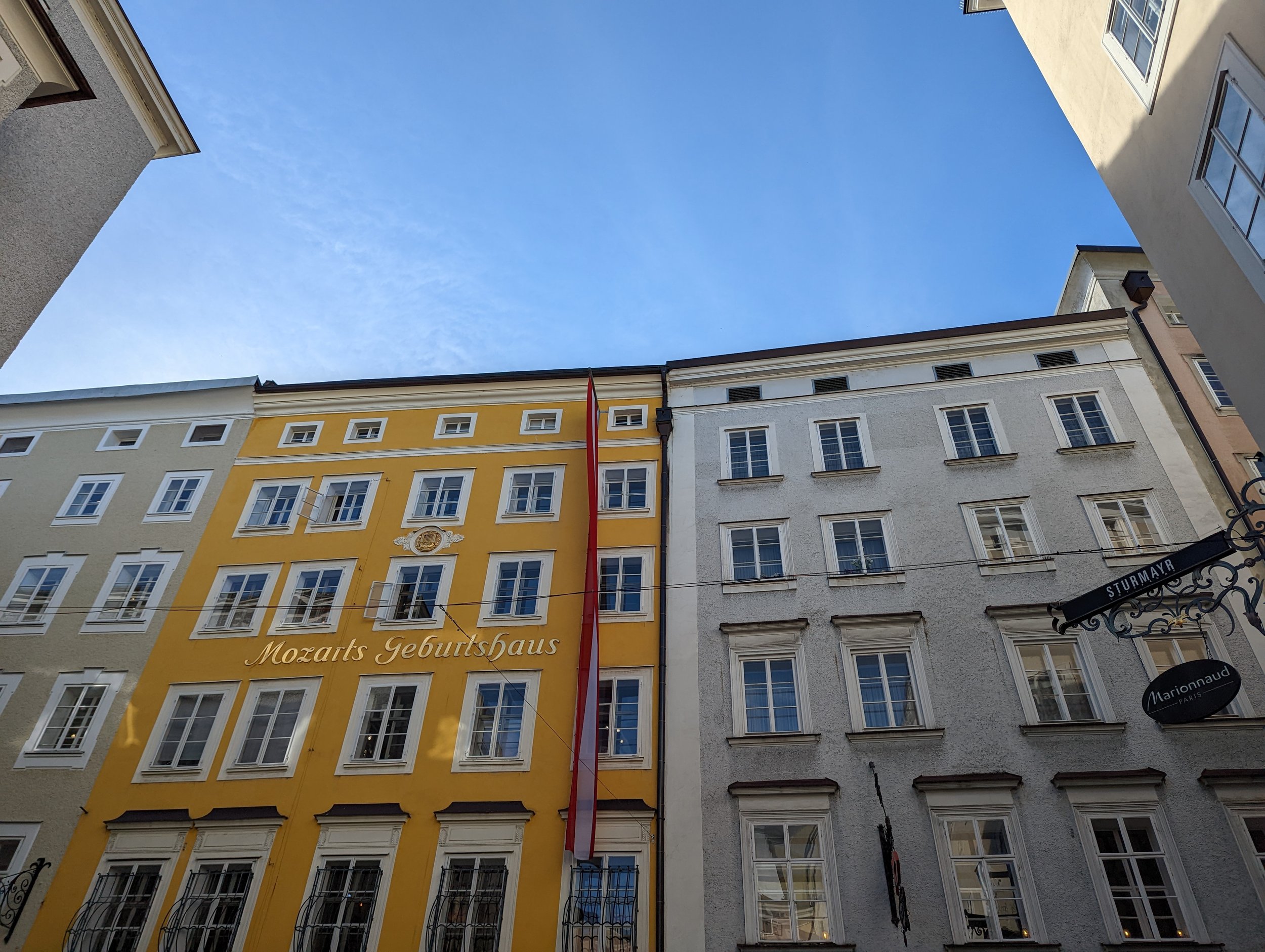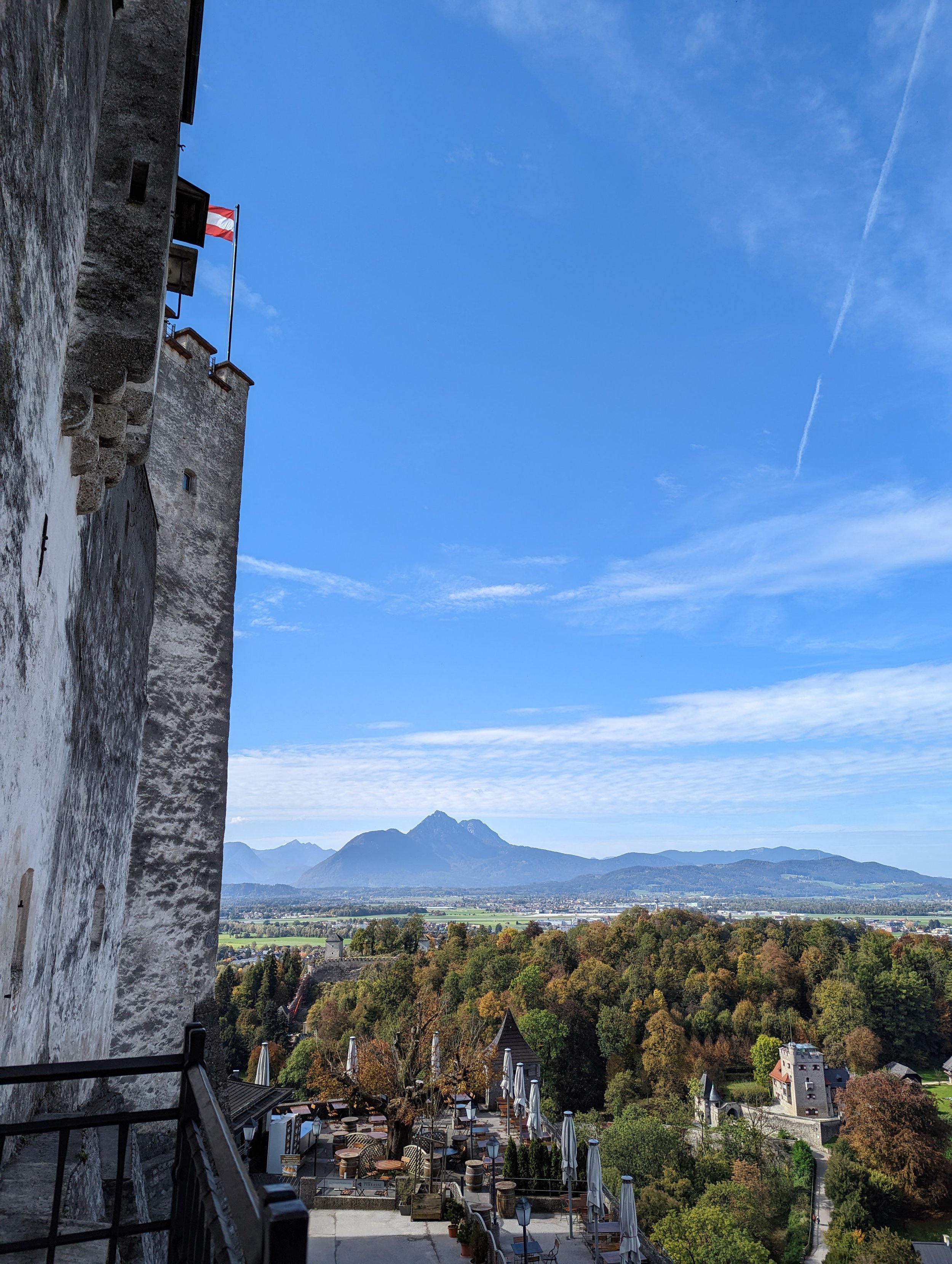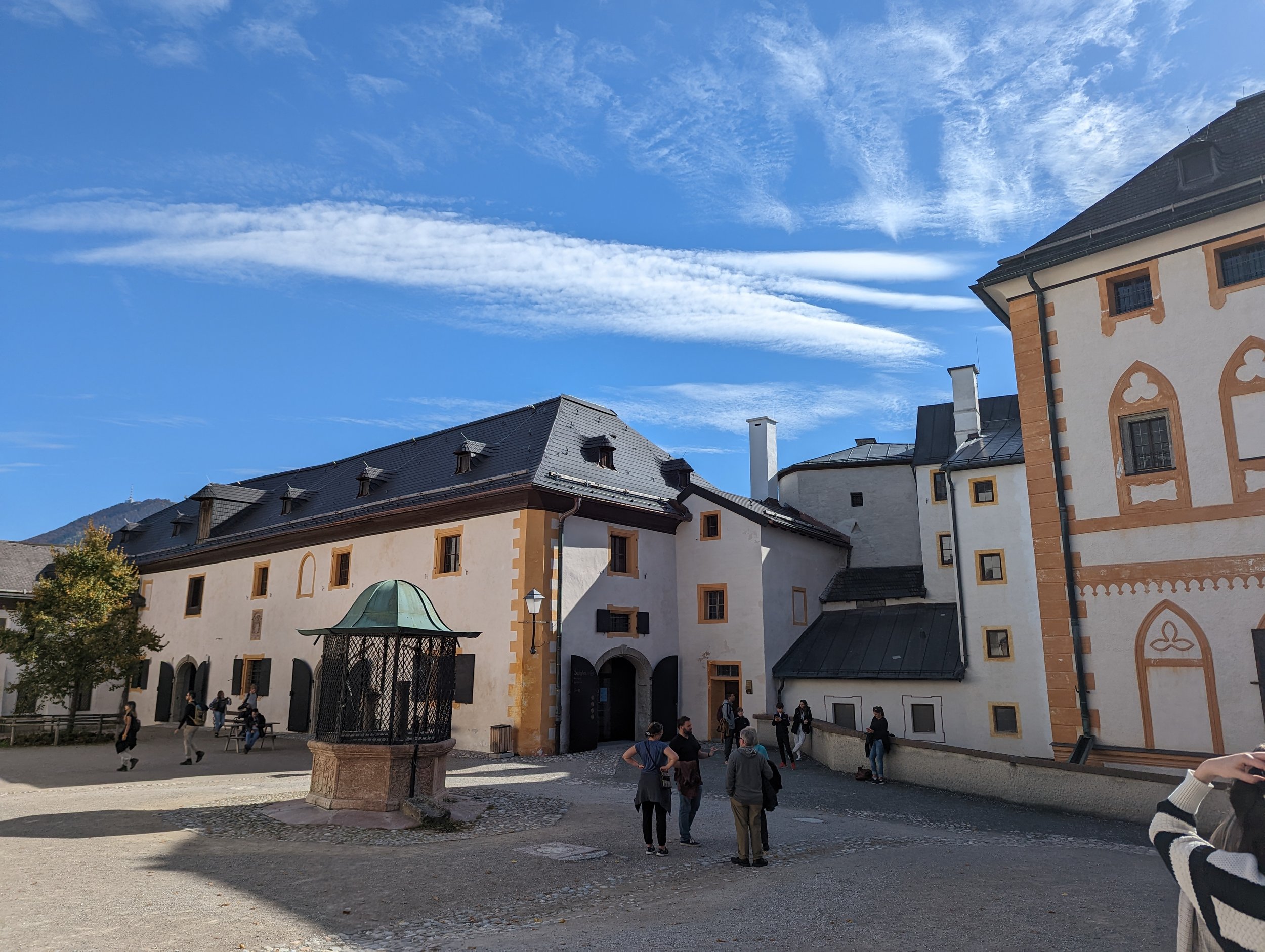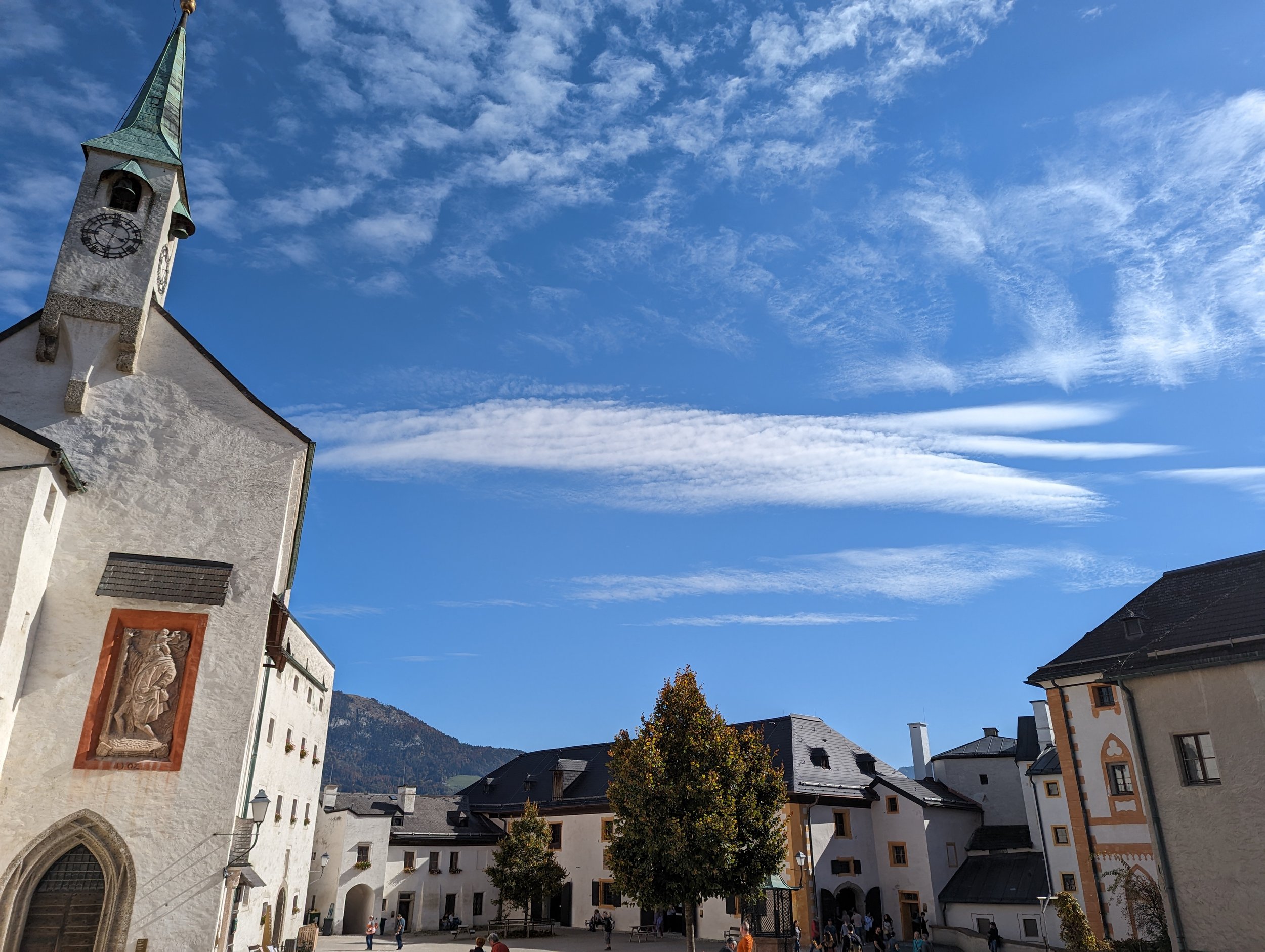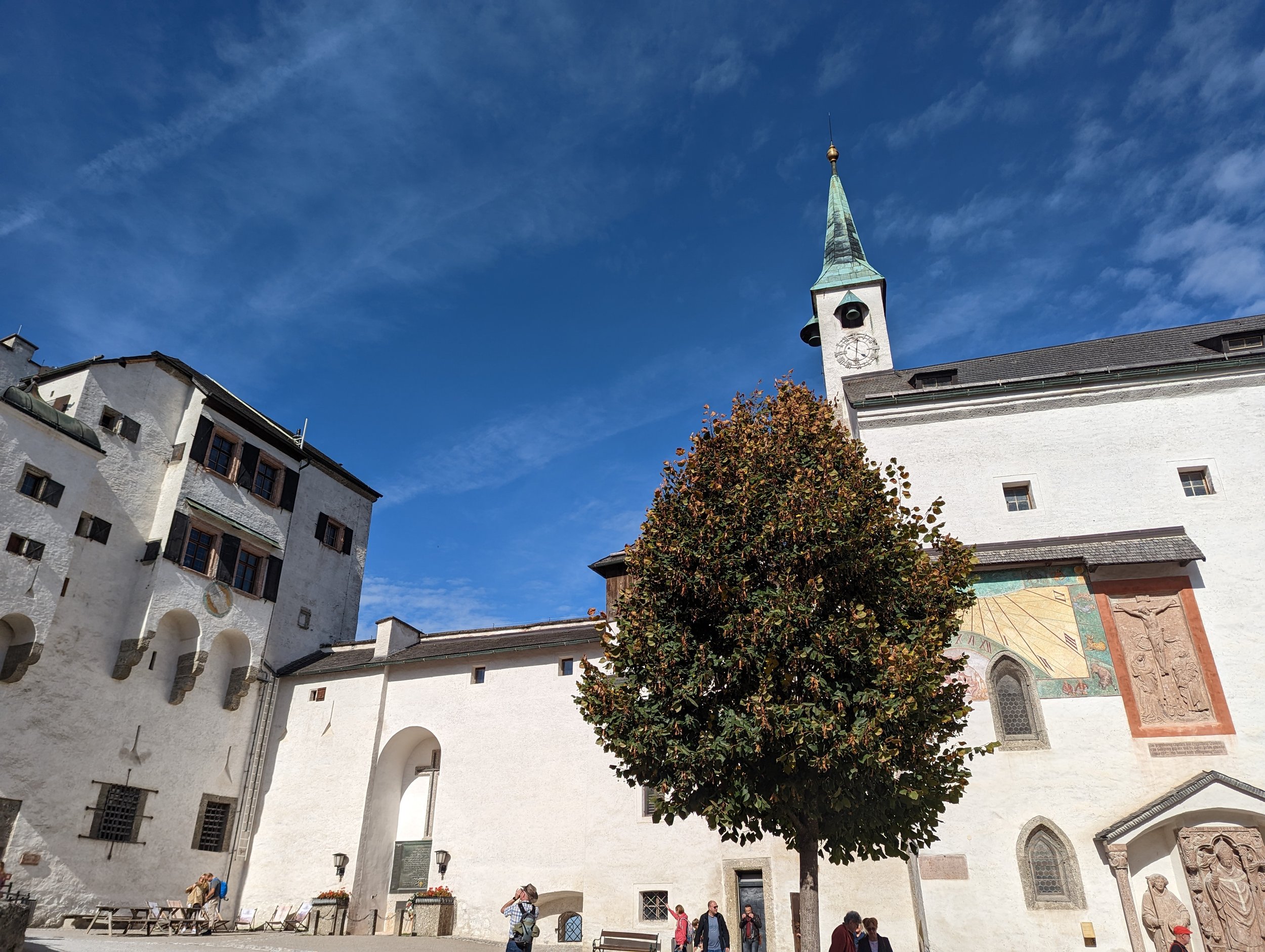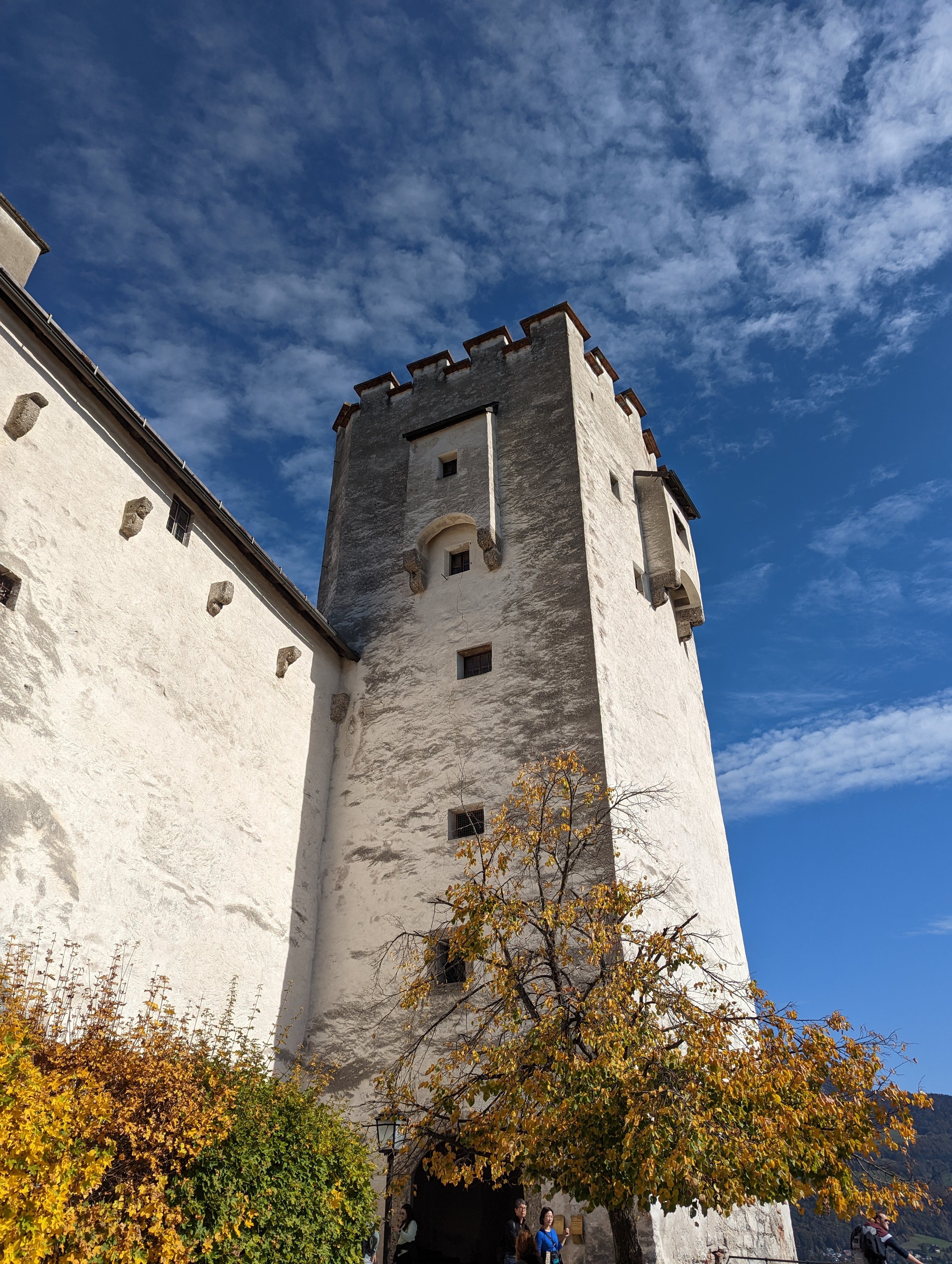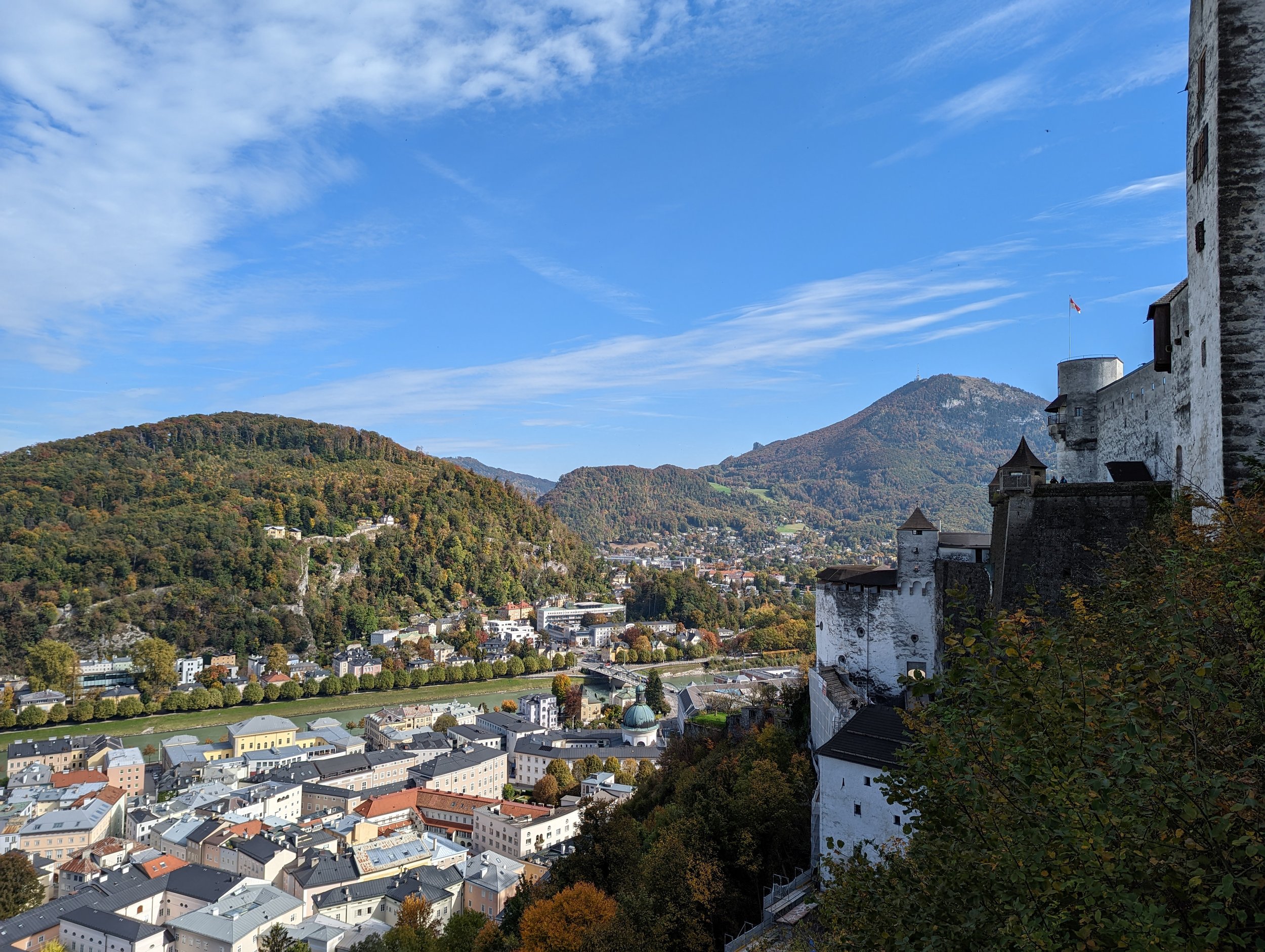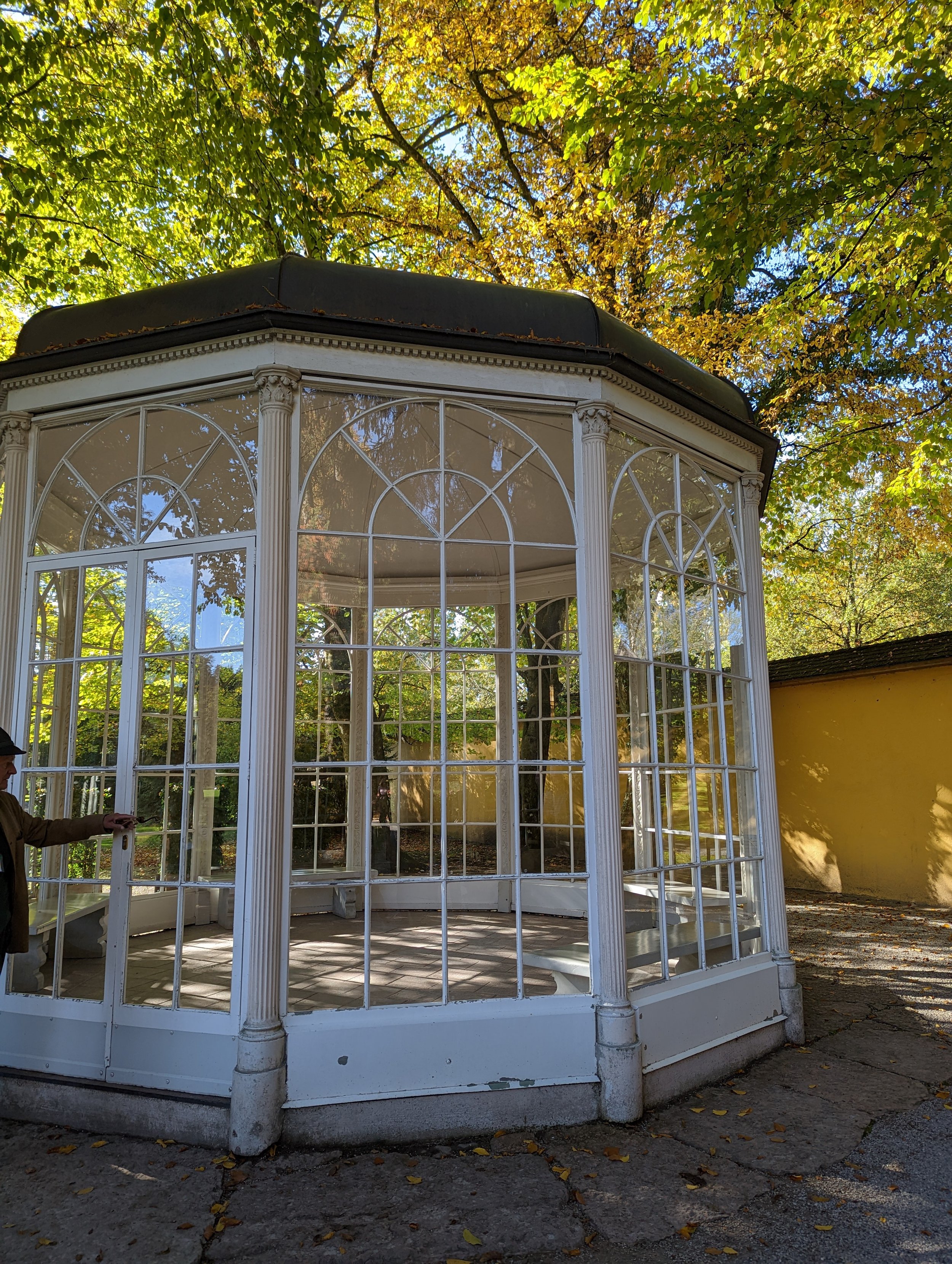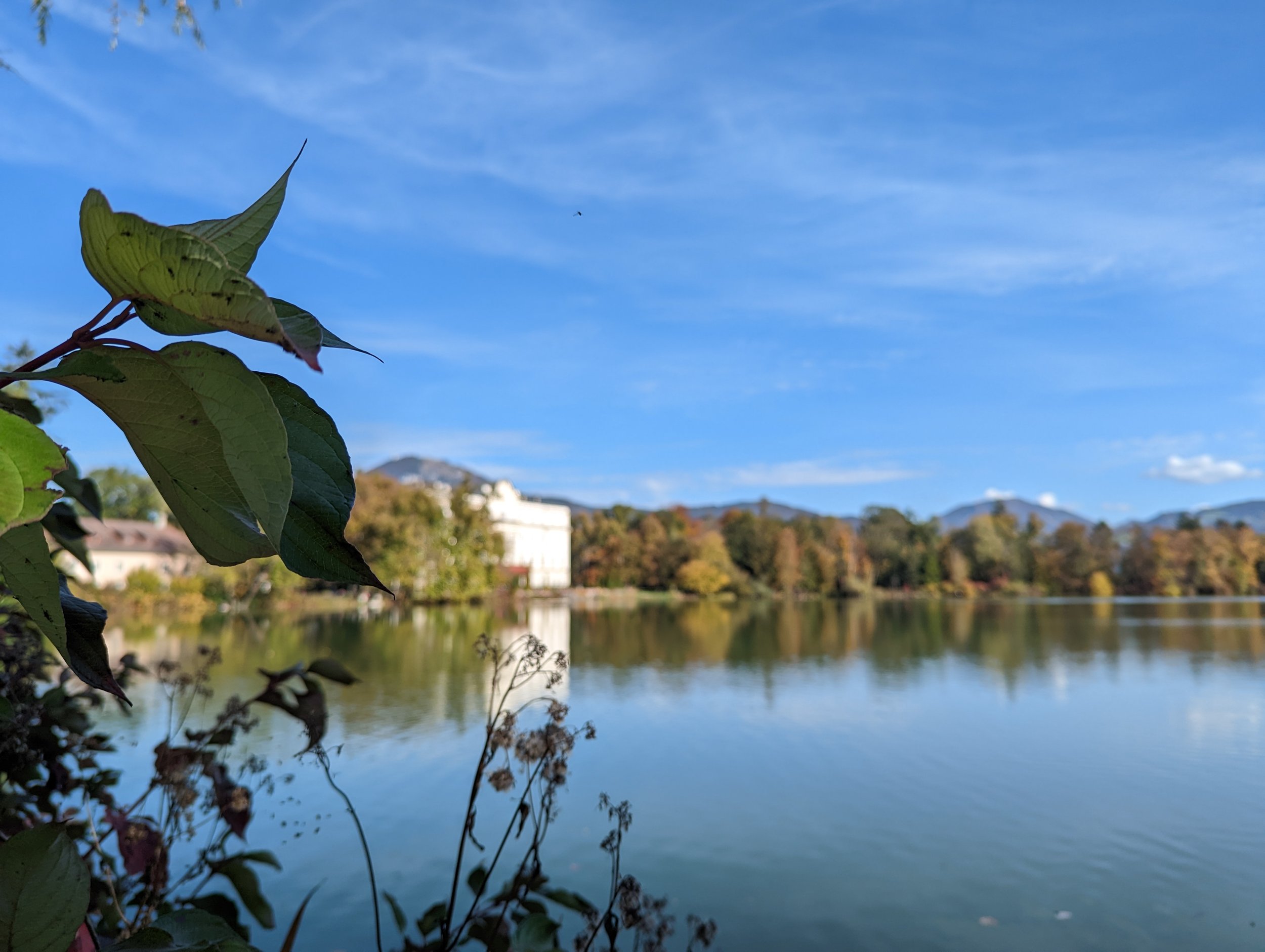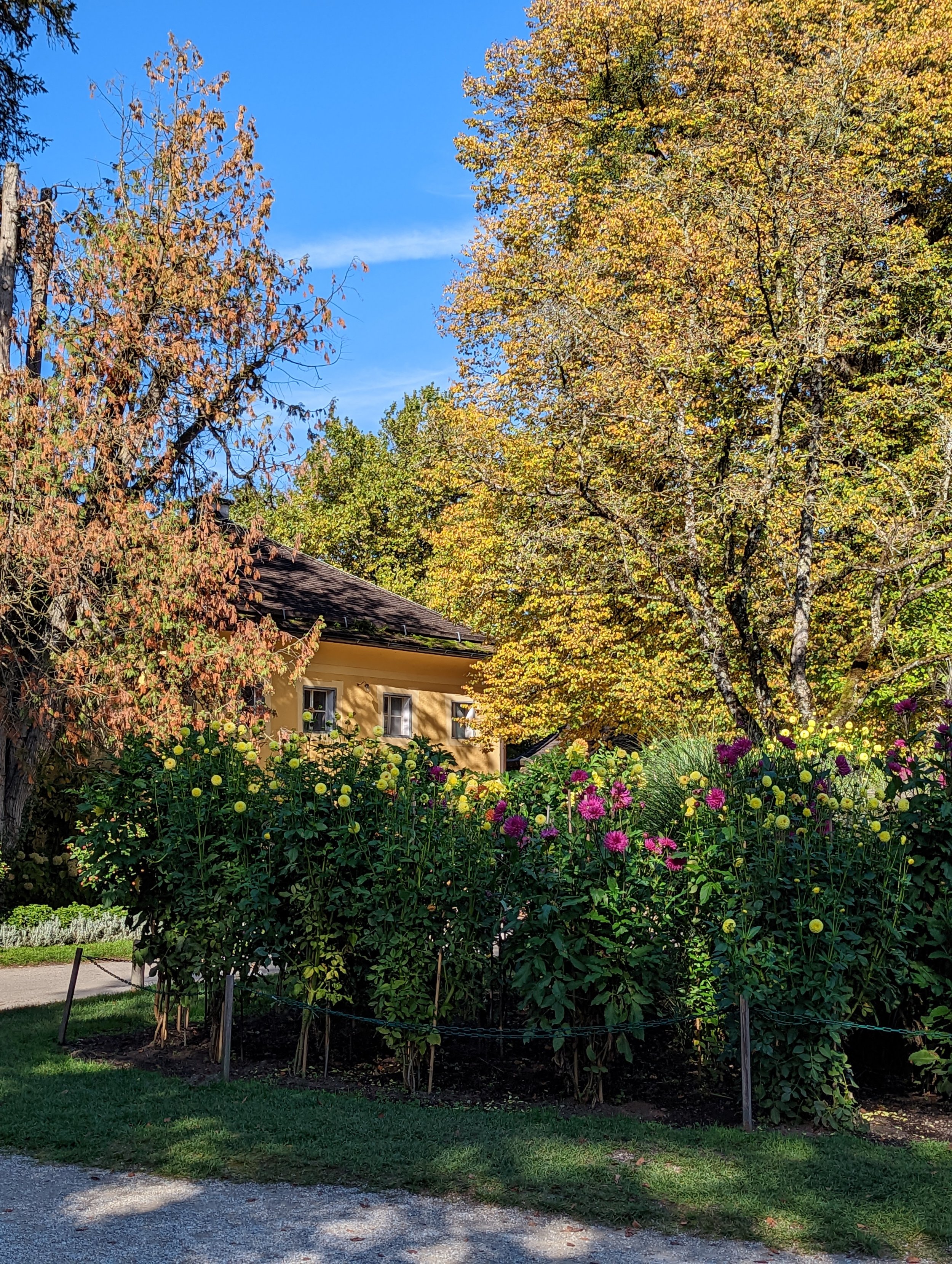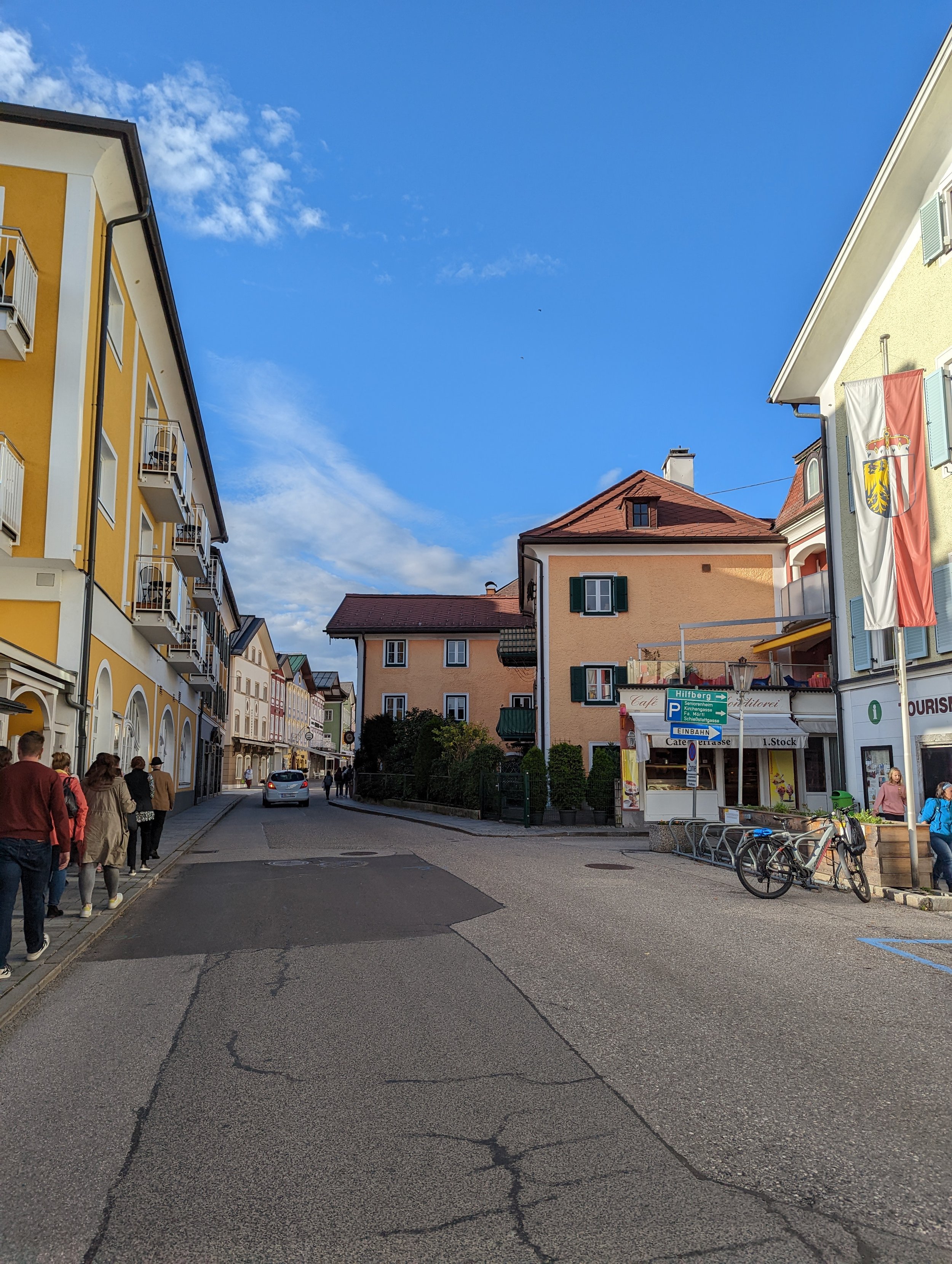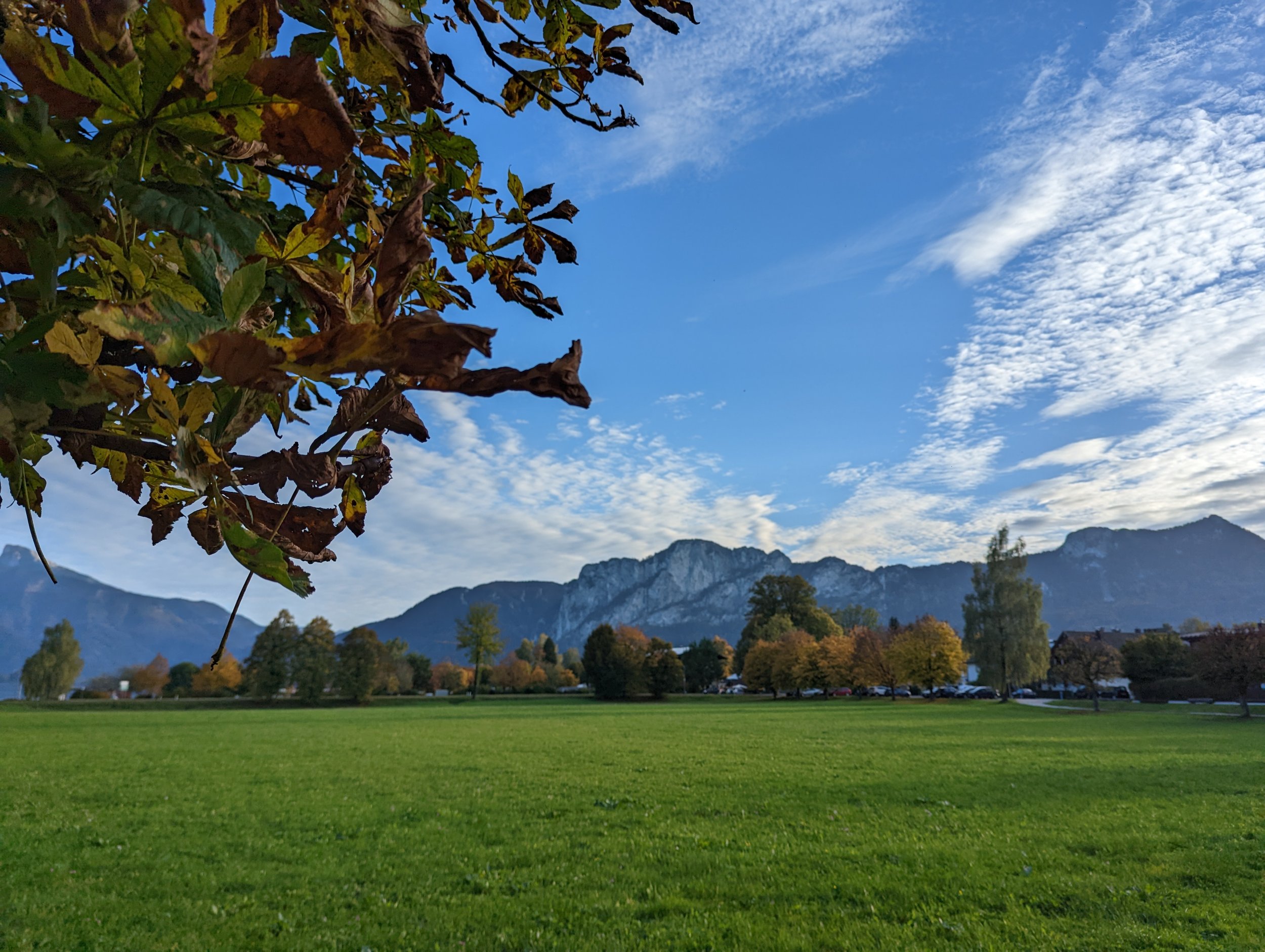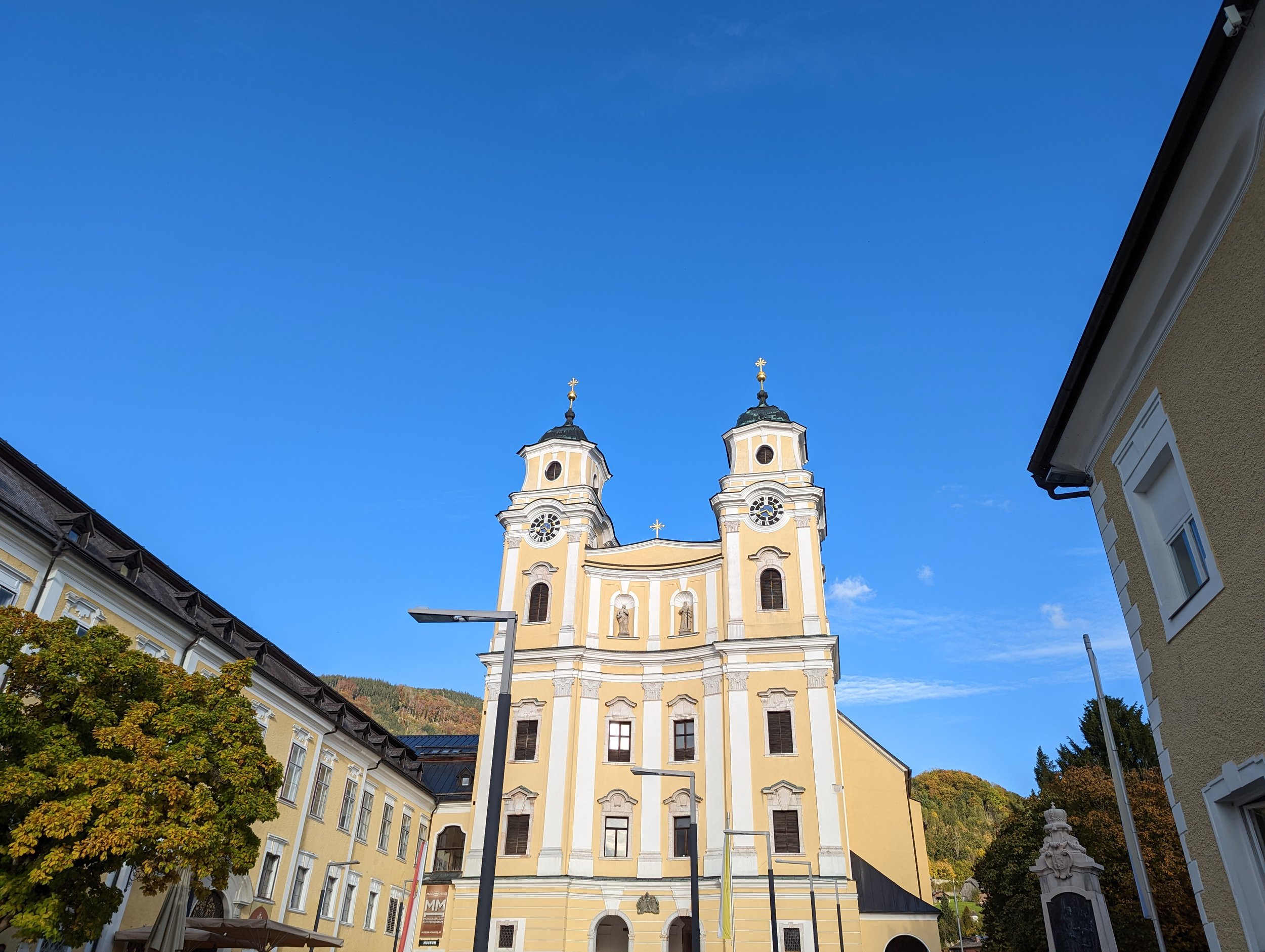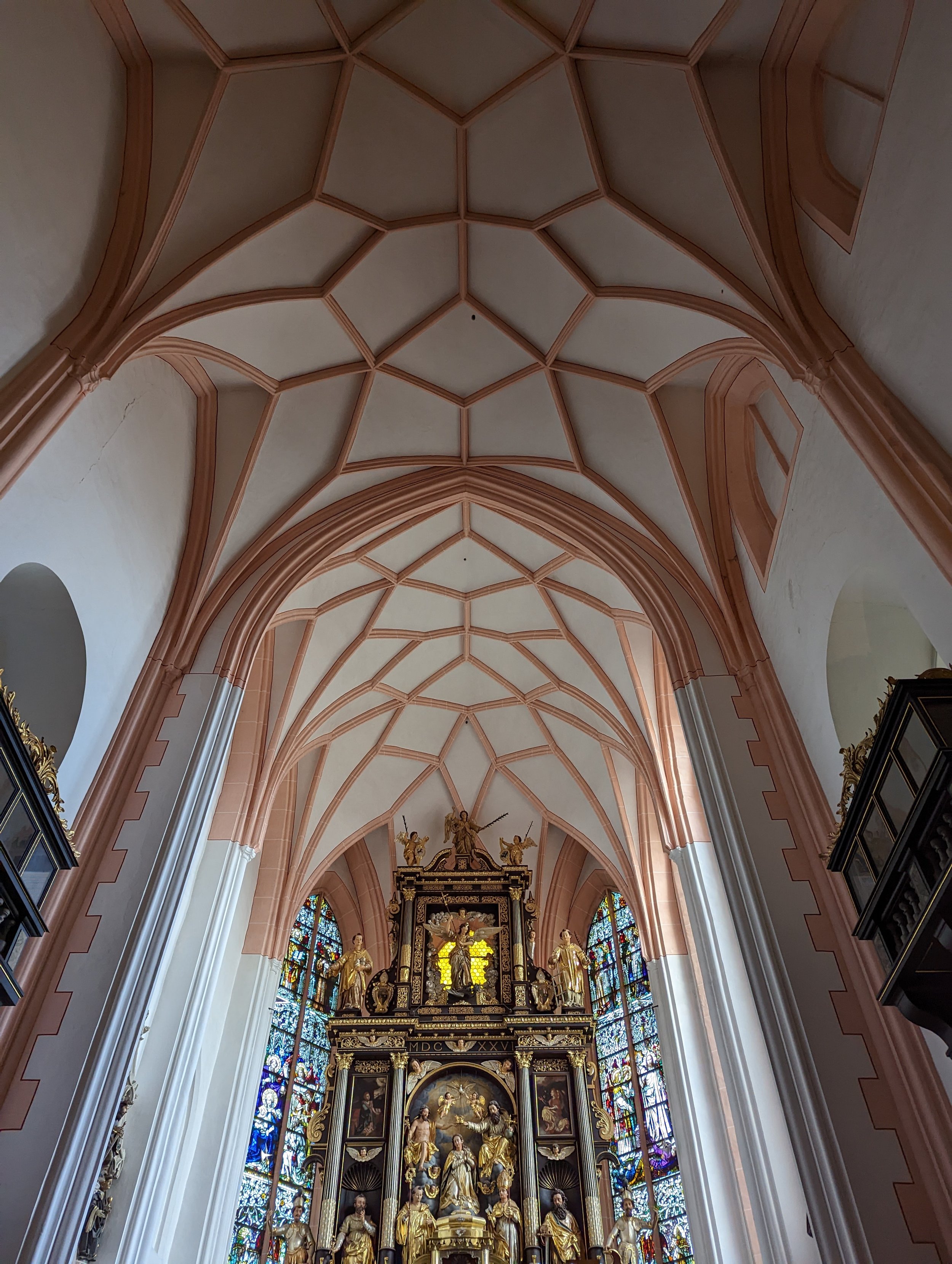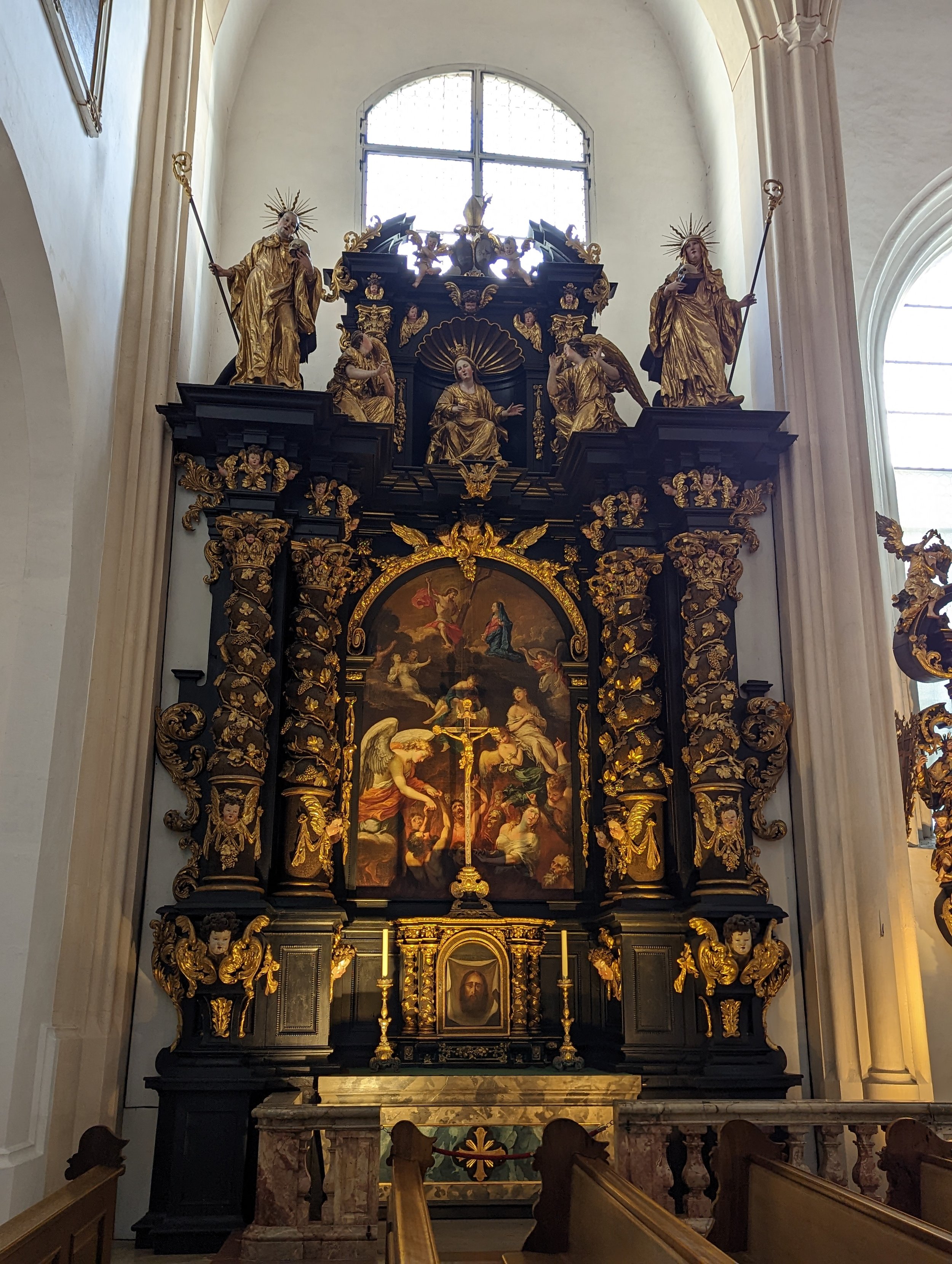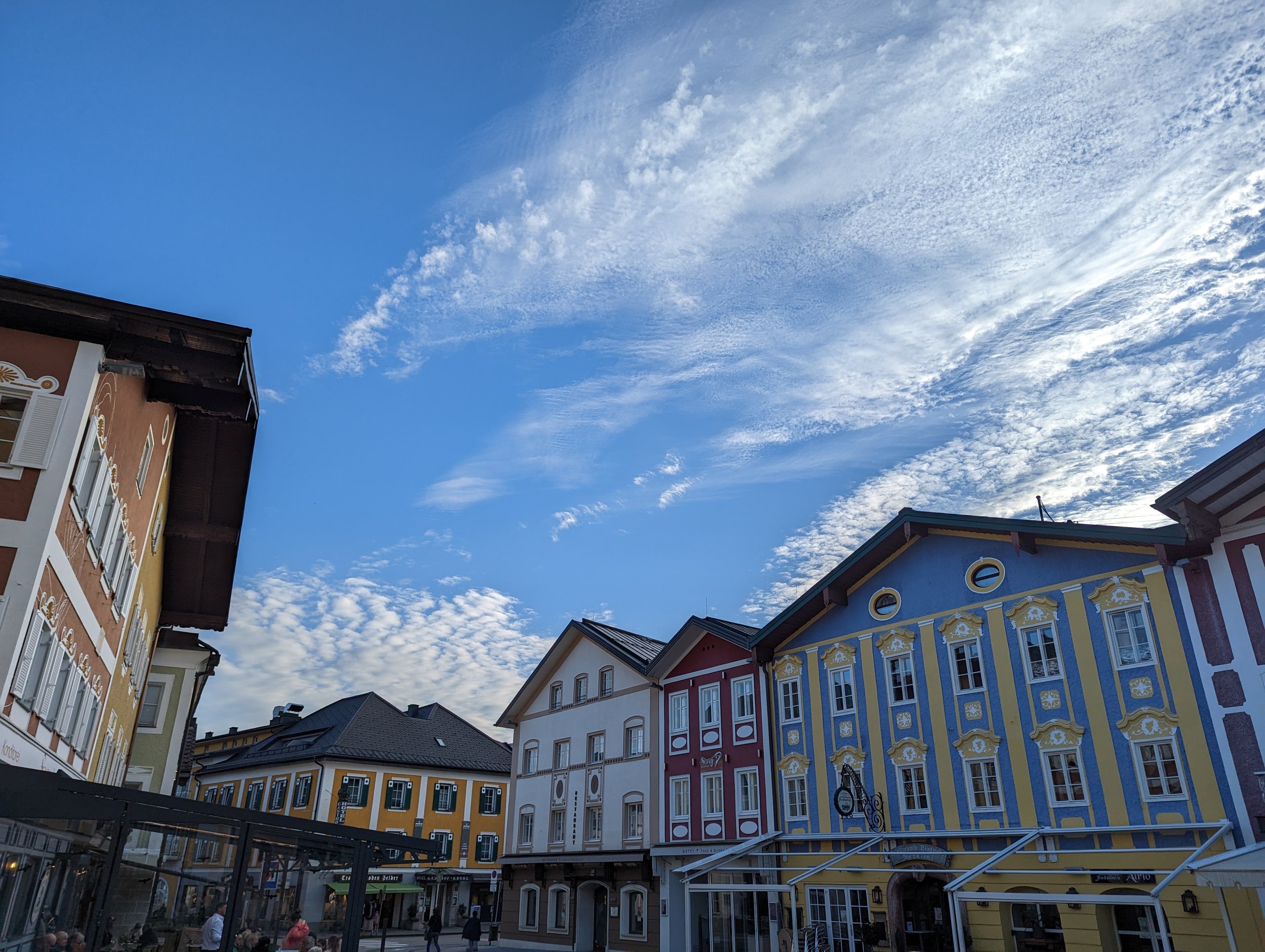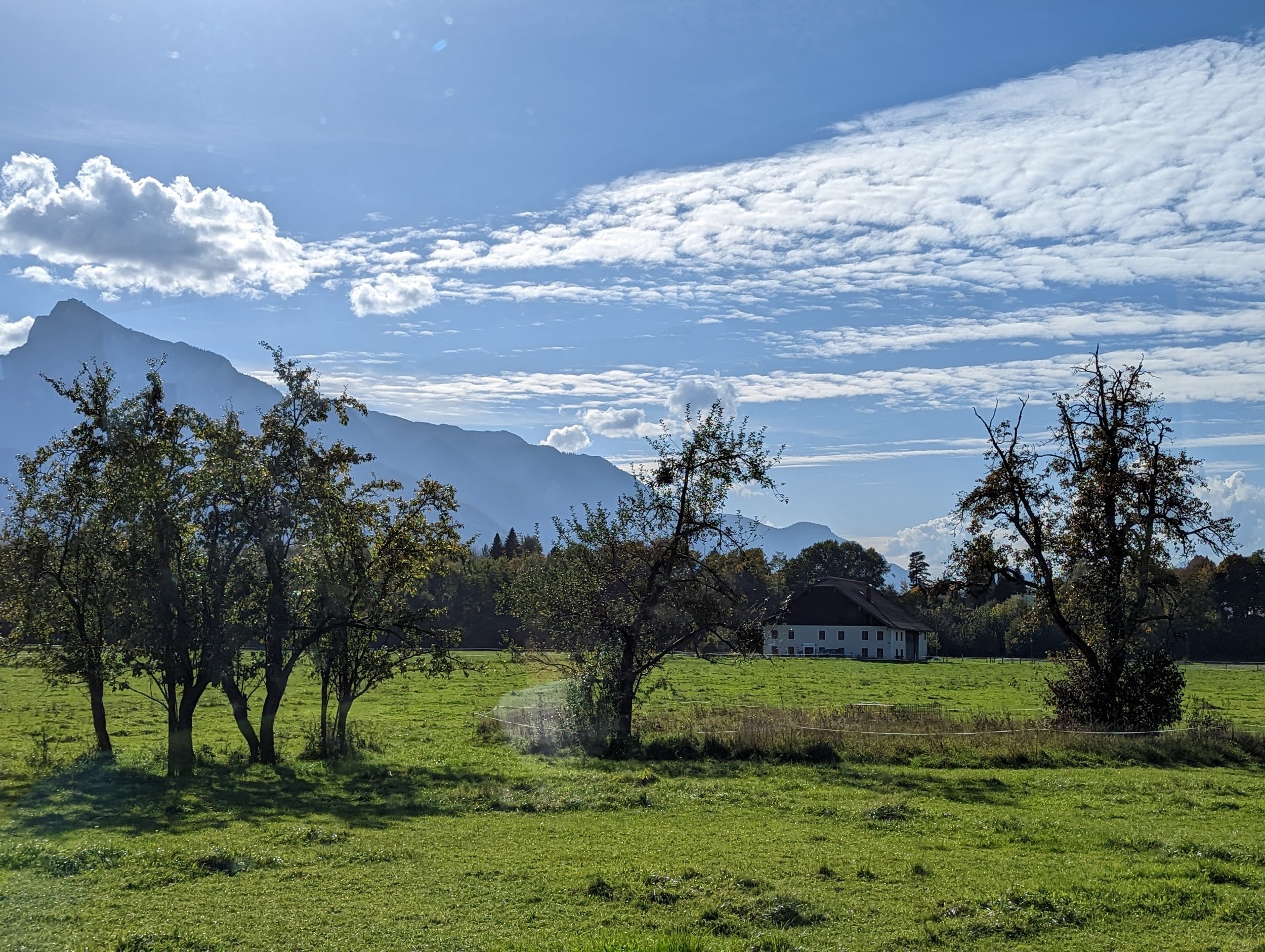Mozart, The Sound of Music, and Mountain Views: A Day in Salzburg, Austria
The Sphaera sculpture on Kapitelplatz below Hohensalzburg Fortress, Salzburg
A bed of blooms in the Mirabellgarten
Early on a Monday morning, I awoke to the sounds of unfamiliar traffic and a gray light filtering through the crack where the curtains met.
Pulling them aside, I looked down on the scene below. Opposite me was a facade of flat-fronted but colorful buildings set above a row of storefronts, the mountains behind cresting their slanted rooftops.
On the street, a line of cars and buses crawled along to a chorus of honking, trailed by thin lines of exhaust that rose into the cool air.
For everyone living in Salzburg, Austria, it was the start of another work week, another commute.
For me, it was the start of another adventure.
The night before, we had pulled into our hotel on the outskirts of Salzburg, worn out from a long day on the road from Italy. Although I’d seen little of this new city so far, it had a distinctive new atmosphere and personality. When my roommates and I popped down to the lobby for a hot tea, The Sound of Music was playing on a loop in the lounge area, and we joined the circle of families and travelers enjoying a quiet evening with the film.
Now, on a fresh morning in the home of Mozart and The Sound of Music, I was ready to explore.
A rainbow crosswalk honoring the LGBTQIA+ community
As our group caught a bus into the center of the city, watching trees and historic buildings speed past, I was struck by how hushed the ride was, how our American accents echoed in the silence of the reserved passengers around us.
I stayed quiet, gripping a loop hanging from the ceiling, trying to blend in. Maybe as a lingering habit from my study abroad days, I hate to look and sound like a tourist. I try my best to mirror the customs around me, to greet people in their own language — and I feel invariably guilty when I can’t. That’s always a part of travel, I think — questioning the social, economical, and environmental ethics of it all, feeling like an intruder, and yet balancing that with the unquenchable thirst to see the world.
We met our walking tour guide, a woman who had lived in Salzburg all her life, in front of the Mirabell Palace — a sweeping, regal building that stretches the length of several streets and is backed by enchanting Baroque gardens. Built in 1606 by Prince-Archbishop Wolf Dietrich, the palace has served a plethora of purposes over the centuries, from banquet hall to modern wedding venue to filming location for The Sound of Music.
Today, the Schloss Mirabell is the home of mayoral and municipal offices, and its palace and gardens are open to the public. In the Marble Hall, where so many couples go to tie the knot, we trailed up the Angel Staircase — marveling at the majestic arches, columns, and intricate carvings — and stood in the ornate, mirrored hall where many wait to see the registrar. I could see my reflection, jeans-and-raincoat-clad, thrown small against the gold and cream grandeur of the walls, clashing with the hall’s age and elegance.
(Below) A walk to, through, and around Schloss Mirabell (Mirabell Palace) and Gardens
In the Mirabell Gardens, famous for being the spot where Maria sings Do-Re-Mi with the von Trapp children in The Sound of Music, we wove through the lush, manicured lawns, passing the Pegasus Fountain, the Dwarf Garden, the Grand Fountain, and the Rose Garden. I felt an instant affinity with the grand, green expanse, where red ivy trailed up the sides of stone walls — both wild and controlled, offering meandering paths, delicate blooms, and quiet spaces for sunny contemplation.
Following our walking tour guide out through the other side of the gardens, we traveled towards Salzburg’s Old Town, a picturesque assortment of domes, spires, and pale pastel buildings across the clear blue stretch of the Salzach River. We stopped before the love-locked Makartsteg bridge, admiring the view. Behind the small patch of historic city, the medieval castle walls of Hohensalzburg Fortress rose up from the Festungsberg mountain.
A panoramic view of Salzburg’s Old Town across Makartsteg bridge and the Salzach River
The Mariensäule (Crowned Mary Statue) backed by the Salzburg Cathedral in Salzburg Domplatz
As we crossed the bridge into the historic center of the city, which is classified as a UNESCO World Heritage site, I could feel the culture and history of the town come alive around me.
We trailed down the narrow, charming streets of the Getreidegasse, Salzburg’s famous shopping district, past storefronts painted in pale greens, pinks, and yellows, ornate signs hanging over each doorway.
We passed through Christmas markets twinkling with delicate ornaments, skirted through wide squares and past street vendors, where we inhaled the mingled scents of fresh frankfurters and pretzels, and stood before the building where Mozart spent his childhood — now a museum. Our footsteps kept pace with the deep chiming of bells across the city as we emerged into the broad square of the Kapitelplatz, taking in the Hohensalzburg Fortress over the golden sphere of the Sphaera sculpture.
In the Grand Cathedral Square, we squinted up at the green-domed towers of the cathedral and the marble statue of the Virgin Mary; if you stand on a particular flagstone across the square, our guide told us, you can see her “crowned,” aligning perfectly with the golden circlet held aloft by cherub statues attached to the the Salzburg Cathedral.
(Below) Exploring Salzburg’s Old Town and the Getreidegasse, Salzburg’s most famous shopping street
The Kollegienkirche, Collegiate church of the University of Salzburg, in the Universitätsplatz (University Square)
Friedhof St. Peter, the church and cemetery at St. Peter’s Monastery and Abbey
Our walking tour ended at the gates of the Friedhof St. Peter, the church and cemetery of the oldest Abbey and Monastery in the German-speaking region.
I stepped carefully around altar tombs blooming with their own flower beds and, inside the hush of the historic church, dropped a few coins into the altar box to light a votive candle.
I’m not religious, but I’ve always found old churches and cathedrals so calming and centering. The quiet, the utter stillness, reaches deep, and I remember to stop and feel the ground beneath my feet in the whirlwind of sightseeing.
This particular church reminded me of one I visited in Edinburgh, Scotland, as a college student. I lit a candle there, too, thinking of my family across the sea.
Following a friendly stray cat up a road that curved against the Festungsberg mountain, a few trip mates and I purchased tickets to explore the medieval fortress towering over the city.
We stood at the glass-paned front of the funicular as it lurched up the mountain. As we climbed into the sky, we watched Salzburg’s baroque towers grow smaller beneath us.
At the top, we stepped out onto the stone battlements around the perimeter of the fortress, where we were greeted by a sweeping panorama of Salzburg’s green and ivory Old Town. I stood at the edge of the wall by the watch tower, breeze playing in my hair as the bells below rang again. Beyond Salzburg, I could see the expanse of green forests and fields stretching to the far-off Salzkammergut Mountains, which I’d soon see from a closer distance.
It felt like the world was spread out before me.
(Above) Looking down on Salzburg and the distant Salzkammergut Mountains from atop Hohensalzburg Fortress
(Below) Side views from outside the Fortress’s medieval walls
From outside the formidable facade of the fortress, we climbed the stone steps to the interior, where an entire village awaited. Within its walls, the 900-year-old Hohensalzburg Fortress holds a surprising amount of history and attractions. Its bastions and courtyards enclose several museums, including the Fortress Museum, Museum of the Rainer Regiment, and Marionette Museum, and you can wander interactive and well-preserved exhibits of the historic armory, Prince’s Chambers, and dungeon. There’s even a restaurant with gorgeous views out to the surrounding mountains.
Wandering through the old stone corridors and sunny, white-washed courtyards of the fortress, I wished I could stay for hours to explore every corner of this fully-preserved, historic relic.
(Below) Wandering Hohensalzburg Fortress
But sadly, we were only in Salzburg for today — and there was so much more to see.
After circling the stone walls one last time, we headed back down the funicular and retraced our steps back through the city and across the river, stopping for sausages along the way.
Back at the Mirabell Palace, we hopped on a bus for the Sound of Music tour, a scenic four-hour ride around filming locations in Salzburg and the surrounding Lake District. As we circled the streets through and out of the city, our guide — an incredibly well-traveled and knowledgeable man in a Peter Pan cap — told us about the intertwined histories of the film and the city of Salzburg.
He told us how for decades, the people of Salzburg were willfully unfamiliar with the world-famous film — how they would not watch it because it triggered painful memories of the German occupation during World War II. Now, the city tries to own its history, as well as honor the real-life story of The Sound of Music’s von Trapp family, who fled the country in 1938, refusing to cede to Nazi command, and eventually settled in Vermont.
Nonnberg Abbey (founded 714 A.D.), a Benedictine monastery; the oldest convent for women living North of the Alps
We passed Nonnberg Abbey, a still-active convent where Maria in The Sound of Music (and the real-life Maria) trained as a novice. Since the Abbey doesn’t allow visitors, we couldn’t explore the inside, but the centuries-old Gothic church and walls still made for an impressive view.
Traveling into the countryside, we stopped at Schloss Leopoldskron and walked out around Leopoldskron Lake, where we had an impossibly beautiful view of the 18th-century palace. At the Schlosspark von Hellbrunn — the park behind the Hellbrunn Palace — we meandered through colorful rose gardens and down tree-dappled lanes, breaking from the dense crowds that clustered around the reconstructed gazebo from the song “Sixteen Going on Seventeen.” From the road, we glimpsed the pale yellow, baroque Frohnburg Palace, which also featured in the film, and today serves as the Mozarteum Music Academy today.
Schloss Leopoldskron, a rococo palace built in 1736, where scenes from The Sound of Music were filmed
As our bus rolled over the increasingly steep, green hills and into the Salzkammergut Lake District to a soundtrack of Julie Andrews, the dramatic landscape was even more beautiful than the ornate palaces we’d just glimpsed. Steep, craggy peaks pierced the wide sky, cradling vast stretches of azure lakes and clusters of villages in the valleys below. Beyond the windows, the trees blurred in bright bursts of autumn oranges and reds.
A panoramic view of the Salzkammergut, or Lake District region of Austria
As we stepped off the bus in the small village of Mondsee, I thought of another road trip in the mountains, seven years ago — the fiery shades and dramatic slopes of the Scottish highlands in another autumn.
Mondsee, a town of brightly-colored buildings and serene, pastoral scenes, is situated by the pristine Lake Mondsee, one of 76 turquoise lakes that make up the Salzkammergut alpine region. Its cathedral, the Basilica St. Michael, served as the interior setting for the wedding scene in The Sound of Music, although the real-life couple married in the city of Salzburg.
Taking in the olive, salmon, and periwinkle facades that lined Mondsee’s main street on the way to the famous Basilica St. Michael, I felt like I might just be in the most perfect place in the world.
(Above) The main street in the village of Mondsee
(Below) Locations from the Sound of Music tour, including the Schlosspark von Hellbrunn (Hellbrunn Palace Park), Schloss Leopoldskron, the Salzkammergut Mountain region, and the village of Mondsee
On the wide steps of the cathedral, under the pale pink patterns of the vaulted ceiling, I wished — not for the first time — that I could stay here for so much longer, that I could stretch the moments.
But then I thought about how far away this had been all my life, and how far I’d come to be here.
On the bus ride back into Salzburg, and around a wide, wooden table with my trip mates that night, exchanging stories about where the day had taken us, I knew that even when they were fleeting, moments like these were never gone.
I knew I’d take them with me.
One last look over Salzburg’s beautiful Old Town district




